

Bay Area News Group $4.95 A BAY AREA NEWS GROUP PREMIUM EDITION CELEB RATING THE HAP PI NES S ,T H E CURIOS IT Y, TH E ENE RG Y, T H E ID E NT IT Y,T H E EMO TIONS A ND T HE A D VE NT UR E OF G RO WIN G UP More on the back: This artwork represents kids from baby to teen and stretches across the front and back of the publication Open up the magaz ne to see the complete piece. ▶
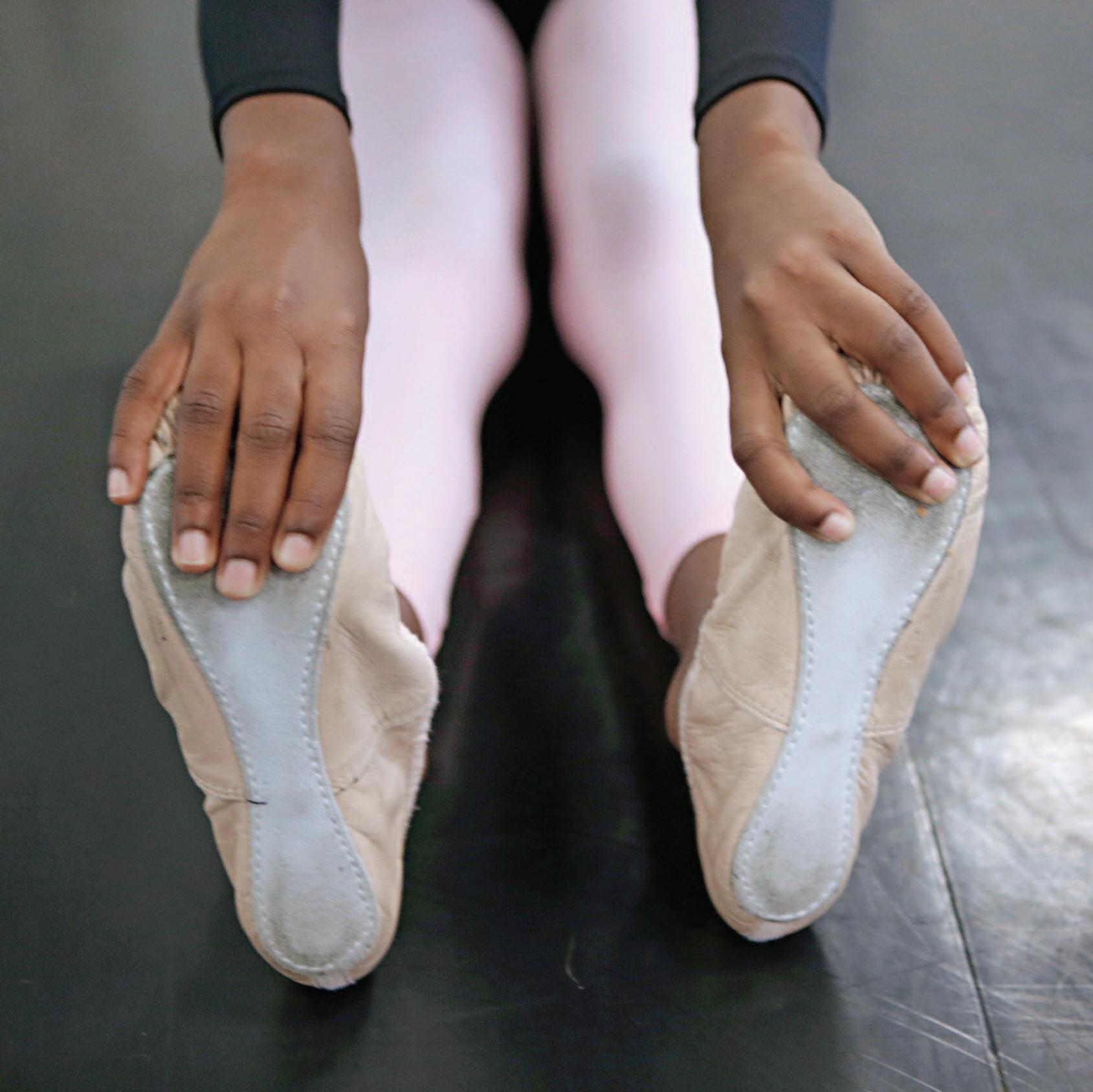
BABY SMILES, SIGNING OPEN THE DOOR TO TWO-WAY COMMUNICATION PAGE 5
TODDLER WHY DO KIDS TIRELESSLY, PASSIONATELY ASK WHY? PAGE 19
GRADE SCHOOLER WHEN SPORTS, ACTIVITIES START TO DEFINE KIDS PAGE 33
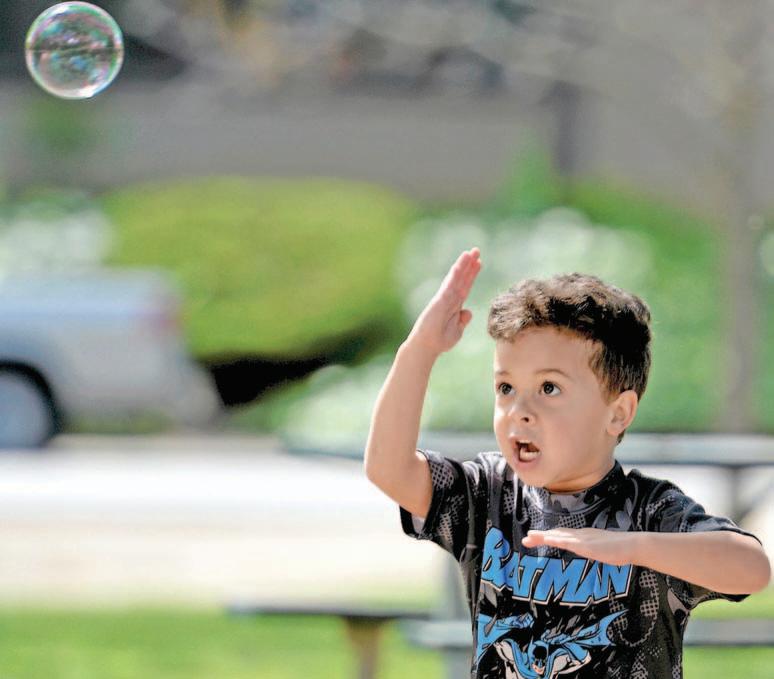
TWEEN WHAT DO THEY THINK ABOUT THE ‘AWKWARD’ STEREOTYPE? PAGE 47
TEEN PARENT-KID BATTLES BEGIN, DESPITE GOOD INTENTIONS BY ALL PAGE 61
JOEL R OSENB A UM/(V A C A VILLE) REPOR TER; OPPOSITE: JIM GENSHEIMER
“A person’saperson, no matter howsmall.”
DR. SEUSS, “HORTON HEARS A WHO!”
Orrin Robertson, 4, of Vacaville, pursues a soap bubble.
Cover illustration: Keith Negley Art director: Tiffany Grandstaff Lead researcher/writer: Tor Haugan Photo editor: Jami Smith Copy editors: Tor Haugan, Chris Hutchison, Jaime Welton Postproduction filters were applied to portraits in this publication.
In their words
BY RAYCHAVEZAND SALPIZARRO
Kids say the darndest things, right? It’s a cliche that still rings true but not always for the reasons it used to. We spent a day at the Rotary PlayGarden in San Jose interviewing boys and girls, ages 3 to 11. We grilled them on their favorite foods, animals and colors. (Purple and pink were favorites among the girls.) Sometimes, we waxed philosophical. And the answers to “What animal would you want to be?” could fill an entire zoo with tigers, zebras, bunnies and elephants. They were a cosmopolitan bunch, too: When asked where in the world they wanted to visit, the globe-trotting answers ranged from Canada and the United Kingdom to Paris and Florida. Of course, both Disneyland and Disney World made the list, and one girl simply wanted to go to the beach. Their future career plans included firefighting, nursing, teaching and studying marine life. We figured we would get some laughs simply by asking what they would do if they were president of the United States. Declare a National Ice Cream Day, perhaps, or maybe make homework illegal? But the kids who grasped the question offered quite thoughtful answers, such as exercising their executive powers to help the homeless and the hungry, or saving the oceans and wildlife. See, kids do say the darndest things. And often they’re worth a listen.
What superpower would you like to have? To be invisible and flying.
What’s your favorite color? Orange. What’s your favorite food? Orange.
TASHIF ZAIN, 5
What’s your favorite food?
I like broccoli.
How do you like to eat your broccoli?
I like to eat it with a fork.
ZERIYA SALINAS
What’s your favorite color? Red, because it’s the color of lava
MOMIN CHAUDHRY 4
If you were the president of the United States, what would you do? Probably help kids get education. Why?
They can learn for the future, and they can be productive adults when they get older CARLY CASANOVA-MOORE, 11
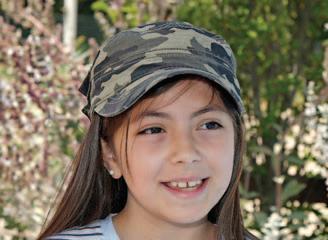
What would you like to be when you grow up? An elephant. And where would you live? In a zoo.
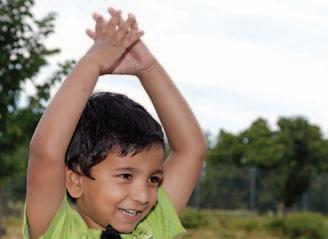 DANIA CHAUDHRY, 4
DANIA CHAUDHRY, 4




KIDS
MIRANDA VEGA, 10
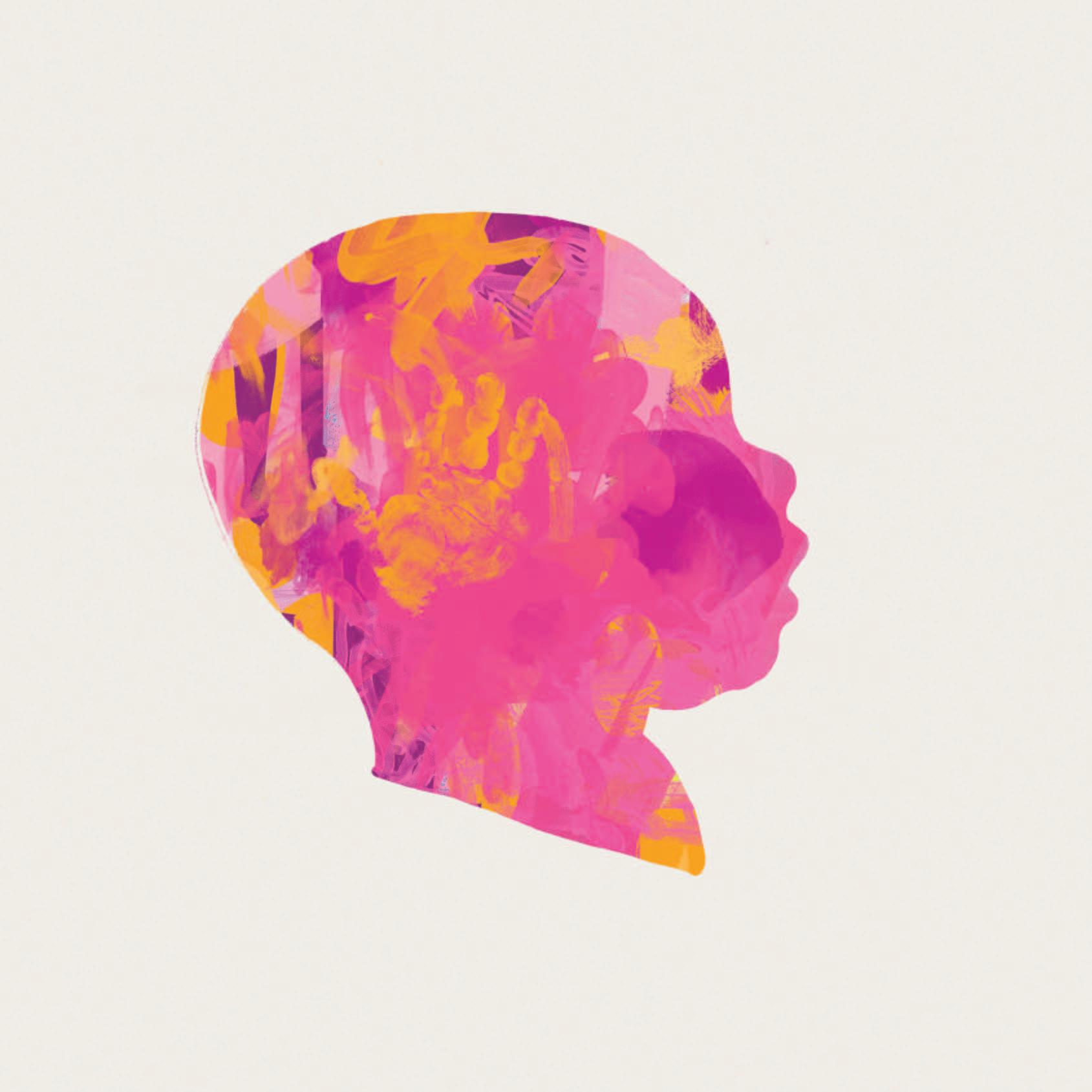
 ILLUSTRATION BY KEITH NEGLEY
ILLUSTRATION BY KEITH NEGLEY
UNS POK EN
Nothingbeats ababy’ssmile. Through these first expressions and baby signs, infants converse with theirparents before they learntotalk.
STORY BY JULIA PRODIS SULEK PHOTOGRAPHS BY JIM GENSHEIMER
6 KIDS BAYAREANEWSGROUP
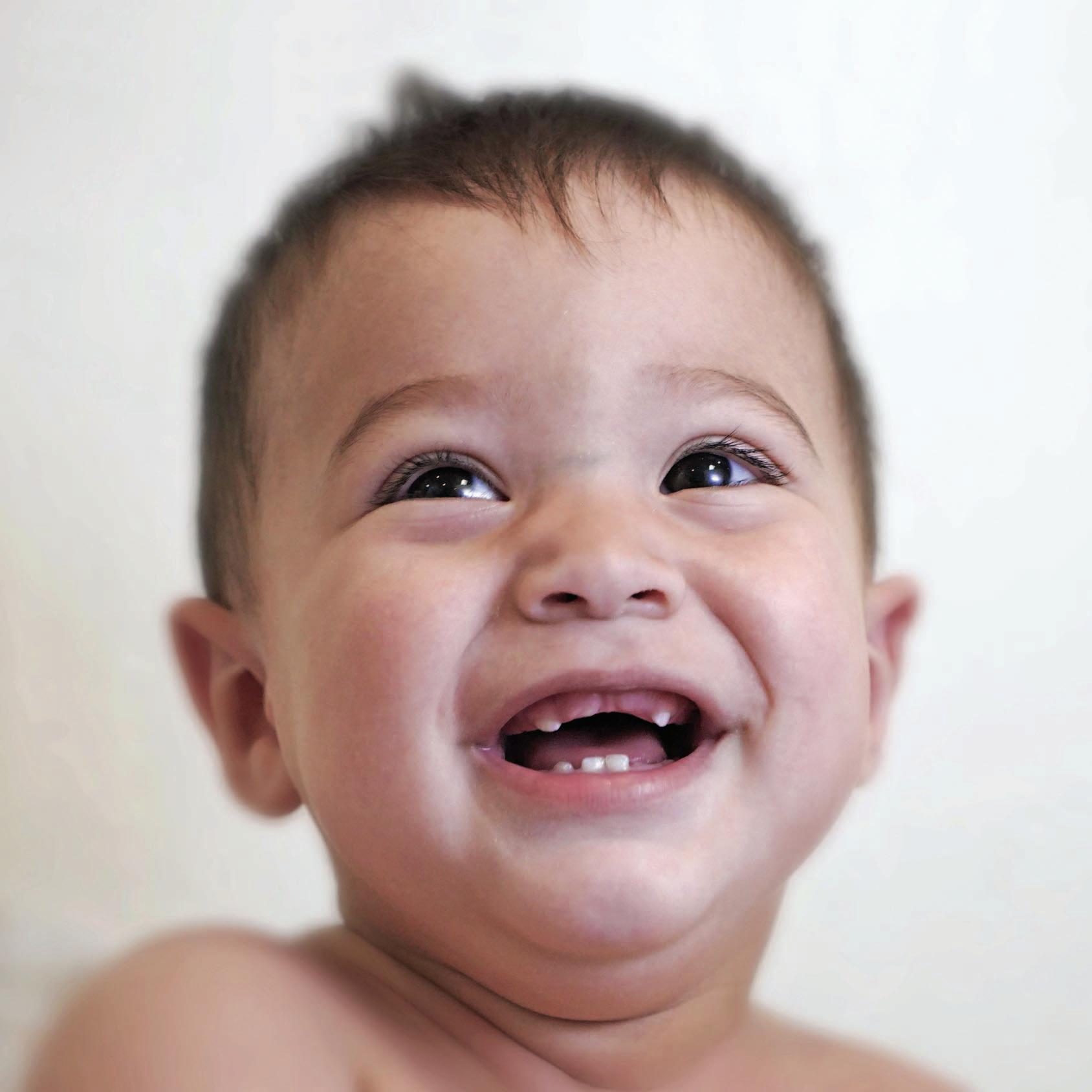

8 KIDS BAY AREA NEWS GROUP
“Finding that one person starts and stops smiling, and the other does the same, it’s the beginning of the social patterns that later become part of the pattern of language.”
DANIEL MESSINGER, UNIVERSITY OF MIAMI PSYCHOLOGY PROFESSOR WHO HAS STUDIED THE SIGNIFICANCE OF BABY SMILES
Babies’ first smiles have always been joyous milestones, the first real signal that they are social beings reaching out to actively engage with their parents.
Increasingly, however, parents want even greater communication with their infants. Long before their children can utter their first words, parents are teaching them baby sign language.
Hungry? Tap fingers to the mouth
More? Tap fingers on both hands together
Milk? Squeeze your hand like you’re milking a cow.
Turns out, infants are far more capable than many of us thought and parents in the highly competitive Bay Area are filling libraries and baby centers for workshops and buying baby sign language kits
For the kind of parents who play Mozart when their babies are in the womb and groom their children to be Ivy Leaguers, studies showing that baby signs raise IQs are irresistible.
“In Silicon Valley, where everyone is taking their kids to swimming classes and music classes, you don’t want to be left behind,” says Cheri Binkley, who with her husband, Peter both of them emergency room physicians brought their twin 9-montholds to the Campbell Library for the baby sign language class one recent morning. “You want your kid to have every advantage to succeed and be intellectual.”
“I just want them to be happy,” Peter chimes in.
Angeline Lopez, of Campbell, and her baby, Lylah, shown here at 11 months, learn to sign during a class at the Campbell Library. Previous page: Ethan Schaetzle, 1, at home in San Jose.

9 BAY AREA NEWS GROUP KIDS
THE FIRST SIGN OF A HAPPY baby? The smile — and that usually comes through by about 2 months. Before they can wave bye-bye or gesture for milk, babies develop their first social relationships by grinning. And really, what parent can’t smile back? What researchers have found, however, is that babies and caregivers develop a rhythm to their smiles babies take turns smiling as parents smile back
“There’s a basic rhythm of communication,” says Daniel Messinger, psychology professor at the University of Miami, who has studied the significance of baby smiles. “Finding that one person starts and stops smiling, and the other does the same, it’s the beginning of the social patterns that later become part of the pattern of language.”
By 8 months, he says, babies smile when they’re looking at a toy, then turn that smile toward the adult.
“It seems like they’re sharing their positive experience with the adult,” Messinger says.
And soon after, that form of communication can expand to include gestures.
NOT ONLY CAN BABY SIGNS relieve frustration and diminish tantrums, they encourage a deeper connection between babies and parents — especially with fathers, who often don’t share the intimacy with their babies that breastfeeding mothers do.

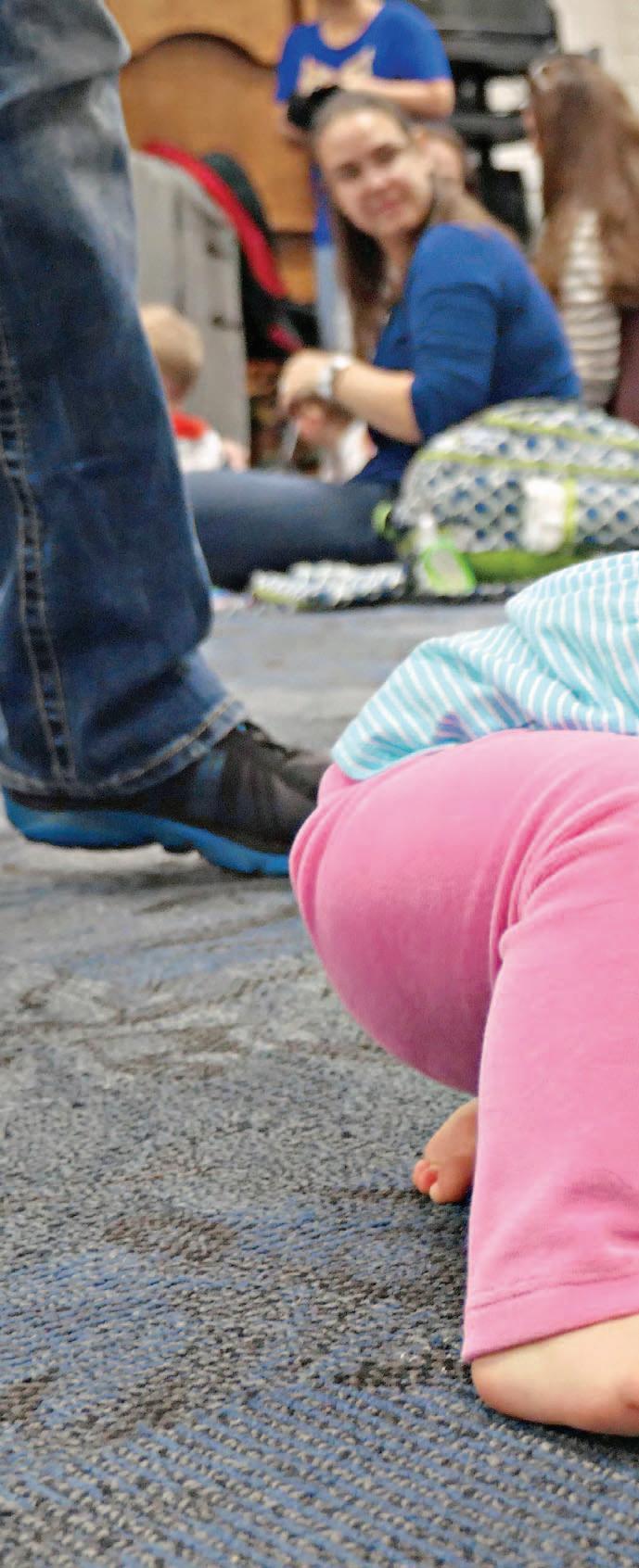

“Before children talk, there’s not a lot of expectation of what they know and what they can feel, what they can think,” says Claire Vallotton, professor of human development and family studies at Michigan State University With baby signs, she says, “parents are thinking about their children as thinking, feeling people, and that is happening earlier”
Some parents haven’t bought into the baby signing precepts.
10 KIDS BAY AREA NEWS GROUP
Above: Ethan Schaetzle, 1, uses signs to ask for more eggs and plays on the floor with his dad, Paul, and brother, Leonardo, 3
Right: Madelyn Lara, shown here at 11 months, of Santa Clara, crawls around after learning baby signs in Campbell

Tony Hoang attended the class at the Campbell Library with his 1-year-old son, Justin, thinking it was just a simple story-time session.
“I’m new to all this stuff,” Hoang says. “I’m like, eh. I can tell when he’s hungry He’ll cry”
Baby signing was pioneered in the 1980s, when UC Davis psychology professor Linda Acredolo and Cal State-Stanislaus professor Susan Goodwyn found that signing babies “scored higher in intelligence tests, understood more words, had larger vocabularies and engaged in more sophisticated play” Their 1996 book, “Baby Signs,” sold more than 400,000 copies
Two-year-olds who had used baby signs, the researchers found, knew about 50 more words than
the children who didn’t By the time they were 8, even though they had long stopped signing, studies found their IQs were 12 points higher than those who didn’t sign, putting them in the top 25 percent of their age group.
STEFANIE JATTA TEACHES
the free signing class at the Campbell and Los Altos libraries always packed — based on the gestures used in American Sign Language
“When I started using signs for my own children I was almost, not embarrassed, but almost afraid to use signs at the park, afraid people might think my child couldn’t hear, that they had issues and were different,” Jatta says. “Really, I was doing signs because it was easier to commu-
nicate. When they were finished swinging, they would sign that they were ‘all done,’ and I knew they were finished with the swings. Instead of having them scream and trying to figure out what they wanted, I knew.”
The age to begin signing differs by the child, and while parents can start modeling signs earlier, babies often don’t have the ability to sign back until they are at least 6 to 9 months old.
“Sometimes people start too early and don’t see results right away,” Jatta says, “and they come to me and say their little one is 4 months old and all he does is stare at me You’re not going to see results if they don’t have the capability.”
For Paul and Socorro Schaetzle, every moment is precious. Six days before their Ethan, 1, was
born, Socorro was diagnosed with a brain tumor. Amid the many visits to the doctor and radiation treatments, Ethan’s first smile was an important moment.
“It’s my sunshine,” Socorro says “It was my motivation to not give up and keep going for both of them, my reason to be alive.”
The baby signing, which they began when their 3-year-old, Leonardo, was an infant, is also making what are often trying times a bit calmer and more rewarding
“It puts away so much frustration ‘Are you crying because you want to sleep or because you want milk?’ ” Socorro says “Every moment, every day you can communicate with them, you have happier moments”
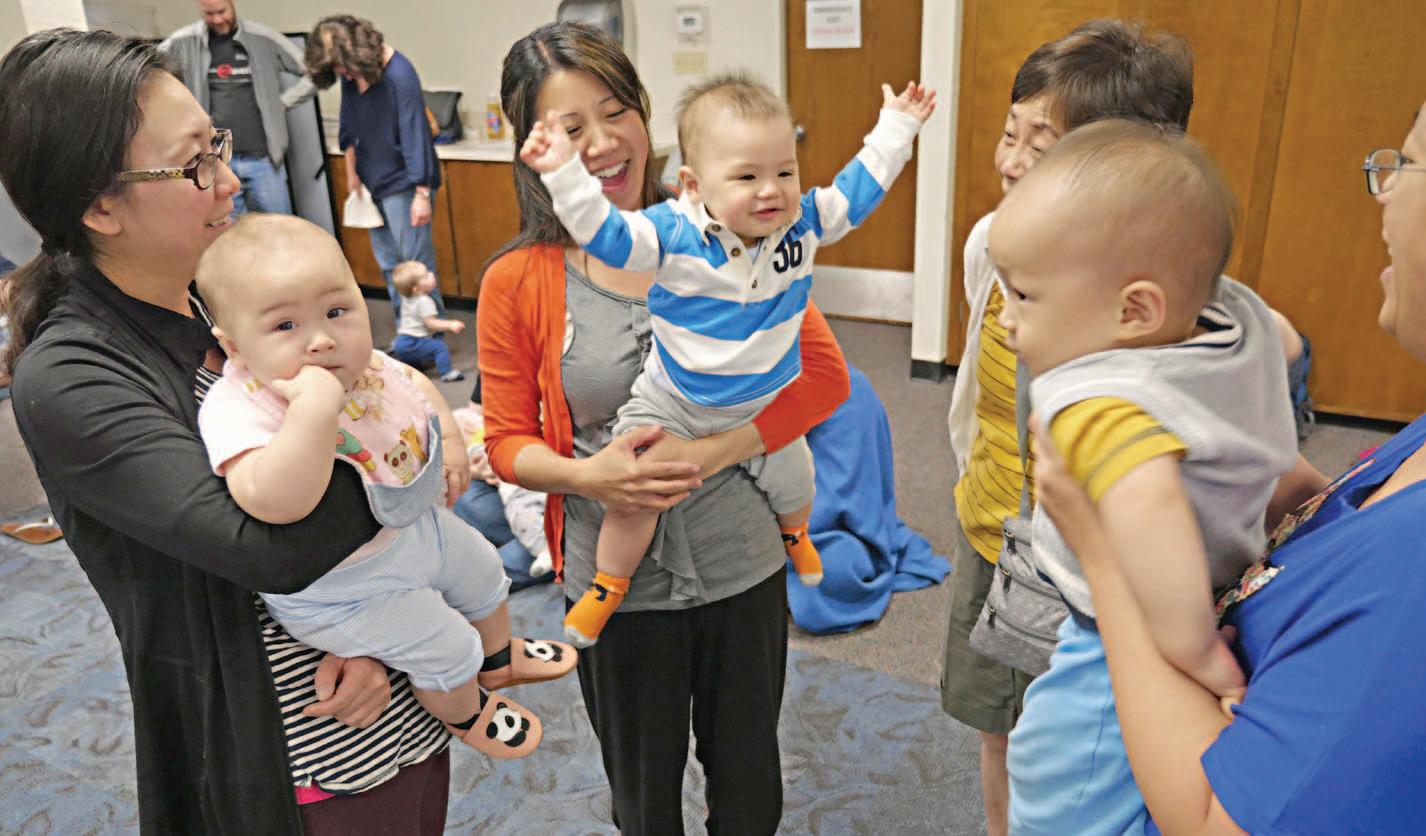
12 KIDS BAY AREA NEWS GROUP
JSULEK@BAYAREANEWSGROUPCOM
From left, Ann Fernald, with baby Madeleine; Charmine Ting, with baby Kyle; and Clara Chen, with baby Sebastian say goodbye after a baby signs class.
Do it yourself
Cloud Dough and Moon Sand
PROJECTCOURTESYOF CHILDREN’S DISCOVERYMUSEUMOF SANJOSE
For a baby, nearly every experience is new, and the world is full of awe and wonder. Sensations that we may take for granted as adults are fresh and exciting. What better way to help your little one explore this new place than by whipping up some Cloud Dough or Moon Sand? After all, stimulation and tactile play are important for babies and can help set the stage for the way they interact with the world around them. These recipes come from the Children’s Discovery Museum of San Jose — it’s the purple building downtown (you can’t miss it) which has been a destination for learning for kids and families since 1990.
CLOUD DOUGH
Add ½ cup of oil to 4 cups of flour, and mix well. For some variety, substitute vegetable oil with scented oils such as baby oil or lavender baby oil For a gluten-free version, substitute flour with rice flour You and your child can investigate the similarities and differences between the textures of Cloud Dough and Moon Sand.
MOON SAND
Homemade Moon Sand, pictured above, is another medium that is soft yet moldable and great for young kids. Mix 6 cups of play sand with 3 cups of cornstarch. Slowly add 1 cup of water, and mix well If sand becomes too dry, use a spray bottle to add a little bit of water to revive it. Be careful not to add too much water or the material will become runny
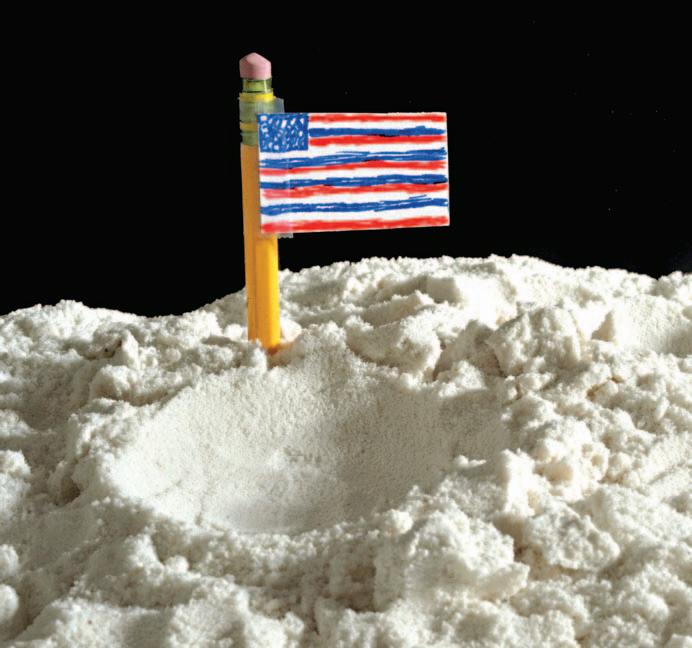
13 BAY AREA NEWS GROUP KIDS BABY
DOUG DUR AN
AND L I T T L ES T
PARENTS’ BIGGEST FEARS
ESSAY BY CHUCK BARNEY ILLUSTRATION BY MARIE ASSÉNAT
Every parent knows that fear and worry come with the territory They start before the child even arrives, and as he or she grows, so does our anxiety. Will we do something to “screw them up”? Will they eat the right things, make the right friends, get into the right college? It never ends. And while no fear is totally senseless, too often we drive ourselves crazy over every little thing. For example, at the newborn stage, I was terrified of dropping our first baby. I’ve never been the, um, most graceful of humans, so I was plagued with nightmarish visions of bonk! — fumbling him like a running back with slippery paws. Or falling down a flight of stairs with him in tow. Or tripping over a toy and causing a “splat.” As it turns out, the fear of dropping a baby is quite common. In severe cases, parents are utterly plagued by thoughts like this or worse, with some crippled by the idea that they will drop or even throw their babies out the window. That anxieties like these, however irrational, are so universal underscores the fact that parents want what’s best for their kids and would do anything in their power to keep bad things from happening to them. I’m proud to say I have never dropped a baby. Maybe I developed Velcro-like hands after my wife, Diane, gave birth. Maybe I was smart enough not to wear socks on hardwood floors. Somehow, common sense and parental instincts kicked in. I made it through the first quarter with no costly turnovers.
14 KIDS BAY AREA NEWS GROUP BABY

15 BAY AREA NEWS GROUP KIDS

Food they’llactuallyeat
MangoCoconut CreamPuree

RECIPE COURTESY OF CLAIREHOYT, BIGDIPPERBABYFOOD
Yes, all of us are familiar with the Gerber jars that line the supermarket aisles. Everyone loves a classic, but check out the Bay Area’s own Big Dipper, whose purees which are lovingly prepared from organic ingredients are far from the pulverized peas of the past. The recipe here has a base of mango and coconut cream, with a bevy of optional additions — mint or curry powder, anyone? so your little one can explore unique flavors before even learning to walk. Remember to introduce the component ingredients one by one to your baby’s diet first to make sure there are no sensitivities or allergies before serving the finished product.
INGREDIENTS
2 cups organic mango (frozen or fresh)
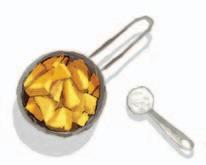
2-4 tablespoons organic coconut cream to taste (You can buy coconut cream, or use the hard cream at the top of a can of coconut milk.)
Optional
Fresh organic mint leaves
Tamarind paste
Curry powder
Organic spinach

Optional: Double your batch, and freeze whatever you won’t use in the next 2-3 days Ice cube trays allow for the perfect portion size.
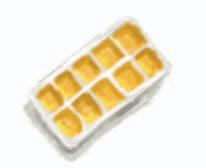
17 BAY AREA NEWS GROUP KIDS BABY
Combine mango and coconut cream. Blend until smooth Optional:
Blend in one of these ingredients: fresh organic mint leaves, tamarind paste, curry powder, organic spinach.
PHOTOGRAPH BY DOUG DURAN ILLUSTRATIONS BY JEFF DURHAM
Seeking serenity
If you’re in the East Bay and want to get away from it all but don’t want to travel too far, look no further than Blake Garden in Kensington. The garden is home to many plants and critters and is used for projects by UC Berkeley students, most of them in the landscape architecture and environmental planning programs. Best of all, it is the perfect destination for an outing where you and the baby can get in touch with nature together while soaking in the natural splendor
Blake Garden is at 70 Rincon Road. For details, go to http:// blakegarden.ced.berkeley.edu.

Out and about
BY TOR HAUGAN
Monsters of folk
Your little one doesn’t have to be Peter, Paul or Mary to have a good time here. Little Folkies is an engaging, educational class that mixes movement with music while teaching little ones about pitch, rhythm and other fundamentals. The class is aimed at kids ranging from babies to 5-yearolds and their parents. You never know your baby might grow up to be the next Joan Baez.
Classes are held in several Bay Area locations For details, go to www.littlefolkies.com.
Get rhythm
Baby Einstein may not make your kid grow up to become a genius, but it’s undeniable that music enriches the lives of children. And there’s no better way to introduce your little one to music than through Music Together. In a relaxed and playful environment, kids from birth to kindergarten, joined by their caregivers, are immersed in melody and rhythm, fostering creativity, selfexpression and other tools that will last a lifetime
Classes are held in the East Bay For details, call 510-848-7464.
Afirst impression
“They grow up so fast” is one of the most overused expressions for a reason: It’s true. And before you know it, your “baby” will be pushing your wheelchair But before that day comes, make sure to cherish every step along the way There’s no better place to do that than at Brushstrokes Studio in Berkeley, where you can have your baby’s footprints and handprints imprinted into clay or onto a piece of pottery for a beautiful memento
Brushstrokes Studios is at 745 Page St. For details call, 510-528-1360.
Making asplash
Think you have a future Michael Phelps (sans the scandals) on your hands? Head to AquaTech Swim School, with locations in Alameda (2203 Mariner Square Loop) and Concord (1220 Diamond Way, Suite 110), where little ones as young as 6 months can take lessons. The Tadpole level helps babies and toddlers, joined by their parents or caregivers, begin to develop skills in the water at an early age.
For details, go to www aquatechswim.com.
18 KIDS BAY AREA NEWS GROUP BABY
ARI C CR ABB
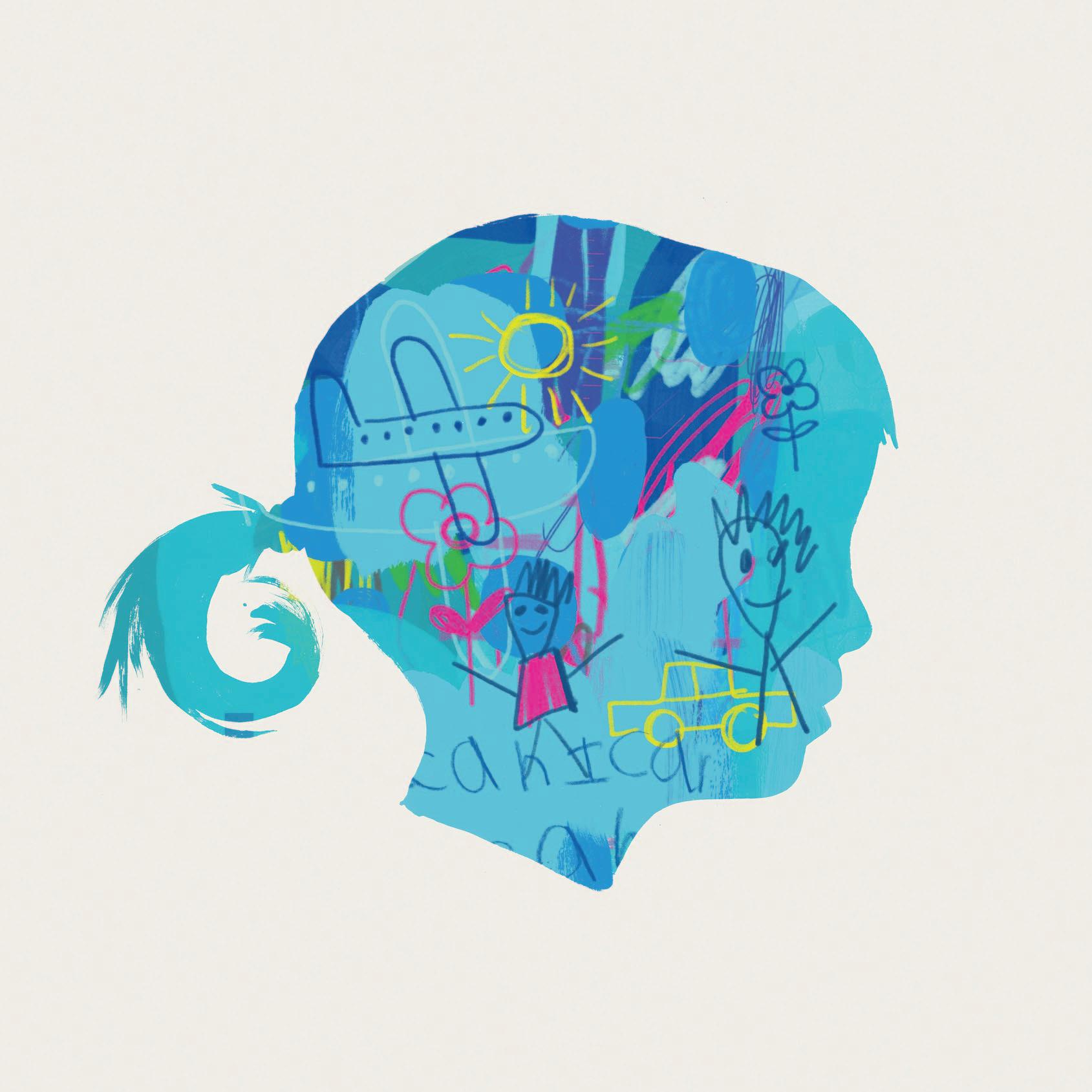
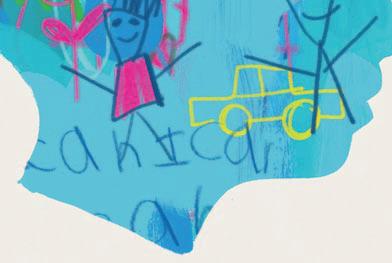 ILLUSTRATION BY KEITH NEGLEY
ILLUSTRATION BY KEITH NEGLEY

THE WHY
CHROMOSOME
Toddlers love to passionately, tirelessly and, yes, sometimes annoyingly question things. But why?
STORY BY BRUCE NEWMAN PHOTOGRAPHS BY JIM GENSHEIMER
WHY ? WHY ? B U T WHY ? WHY ? WHY ? B U T WHY ? WHY ? W HY ? WHY ? WHY ? WHY ? B U T WHY ? WHY ? WHY ? WHY ? B U T WHY ? WHY ? WHY ? WHY ? B U T WHY ? WHY ? WHY ? B U T WHY ? WHY ? WHY ? WHY ? WHY ? WHY ? B U T WHY ? WHY ? WHY ? WHY ? WHY ?

22 KIDS BAY AREA NEWS GROUP
“It gets people talking, and it keepsthemtalking if they keep asking the same question again and again. Parents sometimes get tricked into trying to explain the causeofsomething whichthe kiddoesn’t understand, so they’re not really satisfied.”
DR. ALAN GREENE, A MENLO PARK PEDIATRICIAN AND FOUNDER OF DRGREENE.COM
Robert F Kennedy and his wife, Ethel, had 11 children, so when Bobby brought crowds to their feet during the 1968 presidential campaign with the line that some “see things as they are and say, why,” he knew what he was talking about
At the very moment kids are learning to say the darnedest things, curiosity connects to conversation, and the question begins to fly “Why?”
This interrogatory typically commences around the time rear-facing car seats get turned around and toddlers discover they have a captive audience in the front seat. Girls and boys seem equally adept at lobbing these high-pitched grenades, as both are born with the Why Chromosome.

It is a single word, just one syllable, and yet from the mouths of babes it often is so elongated that each letter seems to stand on its own. When posed by, say, U.S. Supreme Court Justice Ruth Bader Ginsburg, “why” sets up a specific query: “Why did the plaintiff waive his rights?” But from a 3-year-old with an active imagination and all sorts of time, “why” can feel like a finger repeatedly poking you in your chest.
DRIVING OUR DAUGHTER, Nicole, to day care, I proffer a gentle warning.
“I’m going to roll up your window now, honey”
“Why?”
“I don’t want it to get too windy on you.”
“Whyyy?”
23 BAY AREA NEWS GROUP KIDS
Malcolm Lennox, almost 2, pictured here and on the opening page, piles onto his sister, Ella, 5, and brother, Cameron, 8, on their trampoline at home in Saratoga.
“Well, I don’t want you to catch cold.”
“Whyyyyyyy?”
“Hahahaha. Well, precious, that’s because every time you get the sniffles, Daddy ends up with his sinuses in traction.”
“Why?”
And so on. Until the cows come home Not that you should ever bring up the possibility of cows coming to your home in front of a child who is hot to toddle.
“One ‘why’ definitely can lead to another ‘why,’ ” says Laura Lennox, of Saratoga, who is just finishing up the wonder years with 5-yearold Ella and about to embark on them again with Malcolm, now almost 2. “They just keep going until you really don’t know what you’re answering anymore. ‘Why is the sky blue? Why is it not another color?’ And then you have to go Google it. Or you just say, ‘I don’t know. Ask your dad.’ ”
It turns out, toddlers don’t always use language the same

“They just keep going until you really don’t know what you’re answering anymore,” says Laura Lennox, with son Malcolm, above.
“ ‘Why is the sky blue? Why is it not another color?’ And then you have to go Google it. Or you just say, ‘I don’t know. Ask your dad’ ”
way adults do, and they might not actually be seeking the level of detail implicit in their “why”s’ guise. “They learn quickly that it’s a good conversation starter,” says Dr Alan Greene, a Menlo Park pediatrician and founder of DrGreene.com. “It gets people talking, and it keeps them talking if they keep asking the same question again and again. Parents sometimes get tricked into trying to explain the cause of something which the kid doesn’t understand, so they’re not really satisfied.”
ON RARE OCCASIONS, A NOTE
of exasperation from the adult in this exchange arises if the question is posed one too many times.
Comedian Louis C.K., the father of two daughters in life and on his TV show, has rued the “why” Q&A in a stand-up routine that has received more than 15 million hits on YouTube “You can’t answer a kid’s question,” he dadsplains. “They don’t accept any answer A kid
never goes, ‘Oh, thanks. I get it.’ ” Patiently answering a child’s questions when there is nothing else going on is one thing. Dealing with a barrage of whys from the back seat can be a bigger challenge. “It’s just part of being a parent, especially if it comes at the wrong time,” says Dr Stefani Hines, medical director of the Center for Human Development at Beaumont Children’s Hospital in Michigan. “There are times when you’re not in that frame of mind to talk about it. But they’re not looking for a scientific dissertation about why the cow gives milk. They’re looking to bring us into their world, and vice versa.”
Greene agrees: Keep your answers simple. “Just tell a story about whatever it is,” he says. “If they ask why it’s raining, you don’t have to explain how rain happens But if you talk about how rainy days are fun, and rainy days bring puddles, and some days are sunny, and sometimes it snows, it’s so
much easier, and the kids love it.”
After dropping off his 5-yearold son, Hudson, at Action Day Primary Plus day care in Santa Clara, Tony Rondonuwu, an engineer, said he has pursued a different approach.
“He asks about everything!” Rondonuwu says. “‘Why is this? Why is that?’ And then we explain, and he asks again. Sometimes the explanation becomes very deep and technical because that’s the only way to explain. So I give him very scientific answers, and he seems to remember”
What many parents fail to realize is that this exchange between parent and child will be reversed in about 15 years.
“Daddy, I want to get a tattoo.” “Why?”
“I really like them” “Why?”
“My boyfriend wants me to.” No “why”Noway
24 KIDS BAY AREA NEWS GROUP
BNEWMAN@BAYAREANEWSGROUPCOM
Do it yourself
Mandala
PROJECT COURTESY OF LITTLE ARTISTAS, SAN FRANCISCO
Your little Banksy or Basquiat will love this one. This project, which will allow your toddler’s creativity to unfold while exploring a new medium, involves creating a different kind of street art. Make sure you and your child pick a good canvas, whether it’s a nice stretch of sidewalk or a piece of plywood — we were even able to do it on some cardboard. The idea comes from San Francisco-based Little Artistas, a studio that has helped many kids explore fun and creative ways to express themselves since 2013. And don’t worry unlike tagging, you won’t have to worry about this activity being illegal, messy (the paint won’t stain if you use washable liquid watercolors) or permanent.
MATERIALS
Corn starch (½ cup per child), water (¾ cup per child), measuring cups, plastic cups, craft sticks, paintbrushes, droppers, liquid watercolors (in a variety of colors), containers for liquid watercolors, chalk
PROCESS
Tell the kids we’re making a mandala, and ask if they know what it is Draw a large circle with chalk Have each kid scoop out a ½ cup of cornstarch into a cup. Have each kid add a cup of water and mix with the craft stick
Ask them how it feels after each step. Add watercolors to the cups and stir with droppers. Let kids paint a part of the circle of their choice.

25 BAY AREA NEWS GROUP KIDS TODDLER
DOUG DUR AN
DOWN TO EARTH
BayAreakidssee theworld fromalower perspective
PHOTOGRAPHS BY RAY CHAVEZ

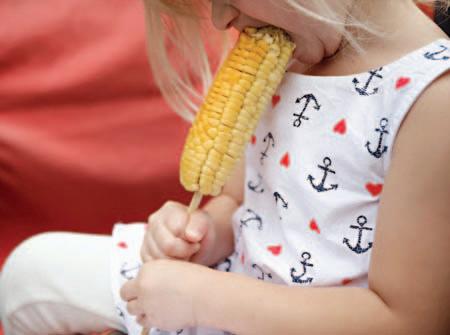

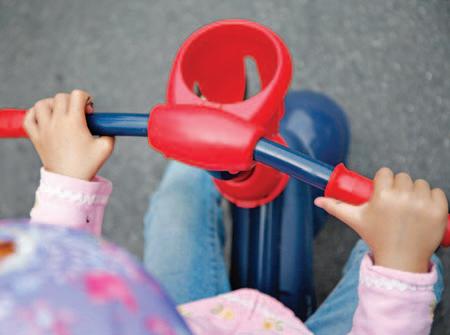
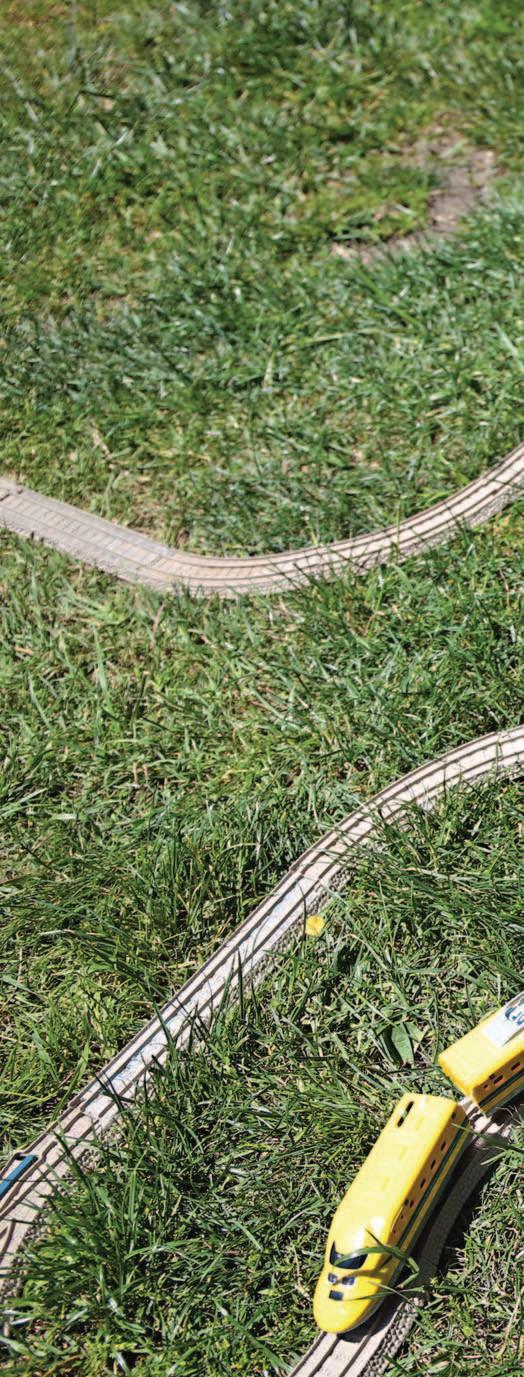
26 KIDS BAY AREA NEWS GROUP
Photojournalist Ray Chavez studied what the Bay Area would look like from a toddler’s height. Larger objects, such as legs or tables, often obstructed the view. But things we often overlook, such as the ground outside and our own hands, took on a new importance. Clockwise from top left: A child bikes at the Campbell farmers market; Everly Sack, 4, enjoys some corn; Miles Fernandez, 5, watches toy trains at Tilden Little Farm in Berkeley; Rowan DeLong and Oliver Leclair, both 3, pull a cart; Kira, 3, holds hands with her mom, Duong Nguyen
TODDLER

27 BAY AREA NEWS GROUP KIDS
AND
L I T T L ES T
PARENTS’ BIGGEST FEARS
ESSAY BY CHUCK BARNEY ILLUSTRATION BY MARIE ASSÉNAT
Behold the germophobe, the obsessive parent who arrives to play dates armed with a vat of hand sanitizer and a stack of heavy-duty wipes. The dad who frantically pressure-washes the binky when it hits the floor. The mom who gives the stink-eye to anyone with a cough who comes within 50 yards of her kid. I cop to being a former germophobe. I was always on the lookout for potential sources of bacteria and disease. I worried about the filthy carpets that David played on, and then, after having them cleaned, I worried about the chemicals that were used to do so. Germophobia, with all its rituals, can help us feel like we are in control, but as the realities of parenting sink in, we realize those feelings are mere illusions. The truth is, there are lots of things over which we are powerless While we may not be able to hermetically seal our kids in their own personal bubbles, we do have control over one crucial thing: the amount of love and support we give them. And that’s what matters most. Nowadays, I roll my eyes at the germophobia of my past. Kids are going to do gross things. They’re going to catch colds. Exposure to germs and dirt even helps to build their immune systems, we’re told. By the time our second son came along, my germophobic tendencies had dramatically waned. When I spotted Sam one day trying to eat a dog biscuit off the floor, my reaction was not to freak out, but to playfully look on the bright side: “Now we don’t have to fix him something for lunch.”
28 KIDS BAY AREA NEWS GROUP TODDLER
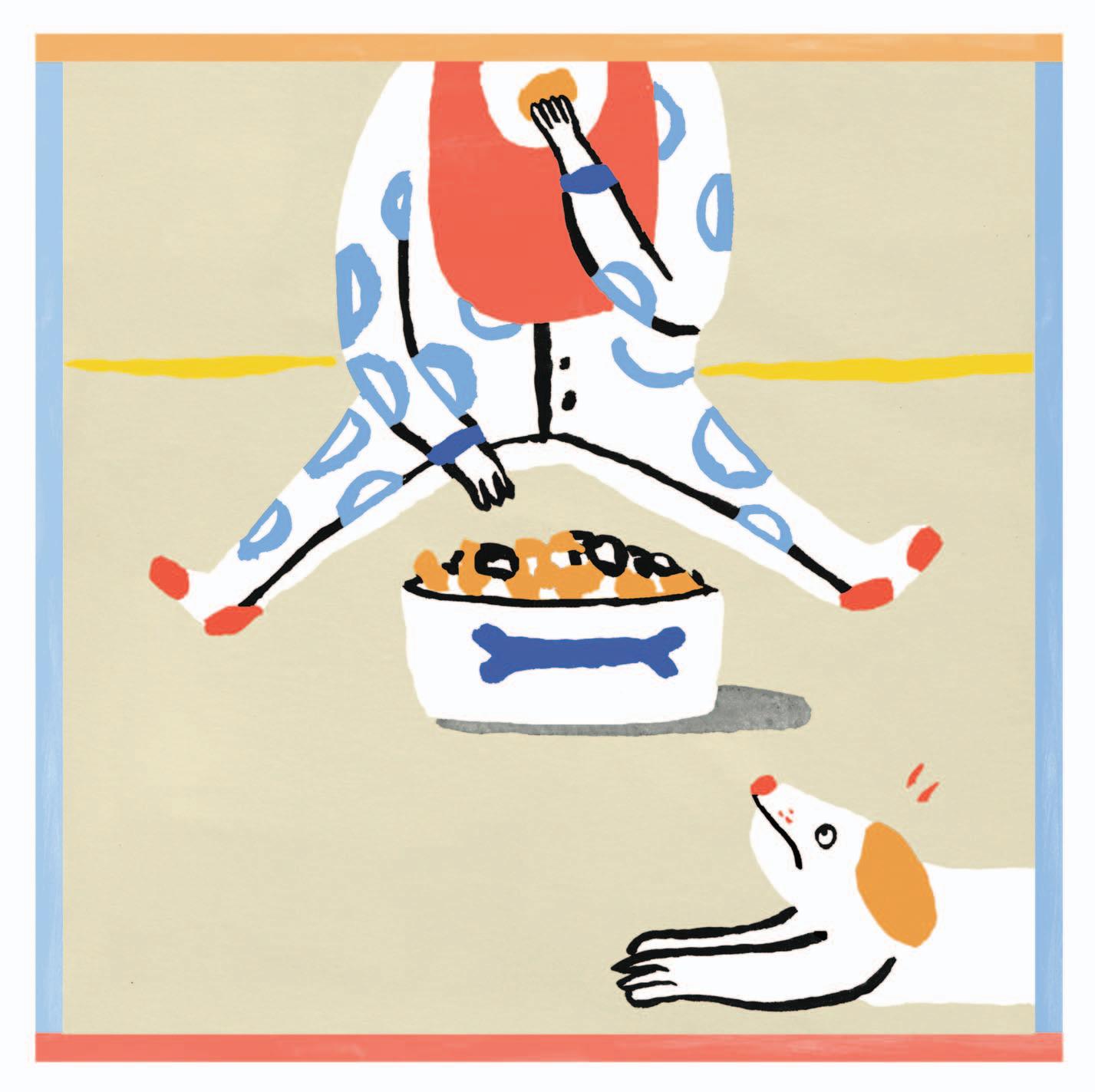
29 BAY AREA NEWS GROUP KIDS
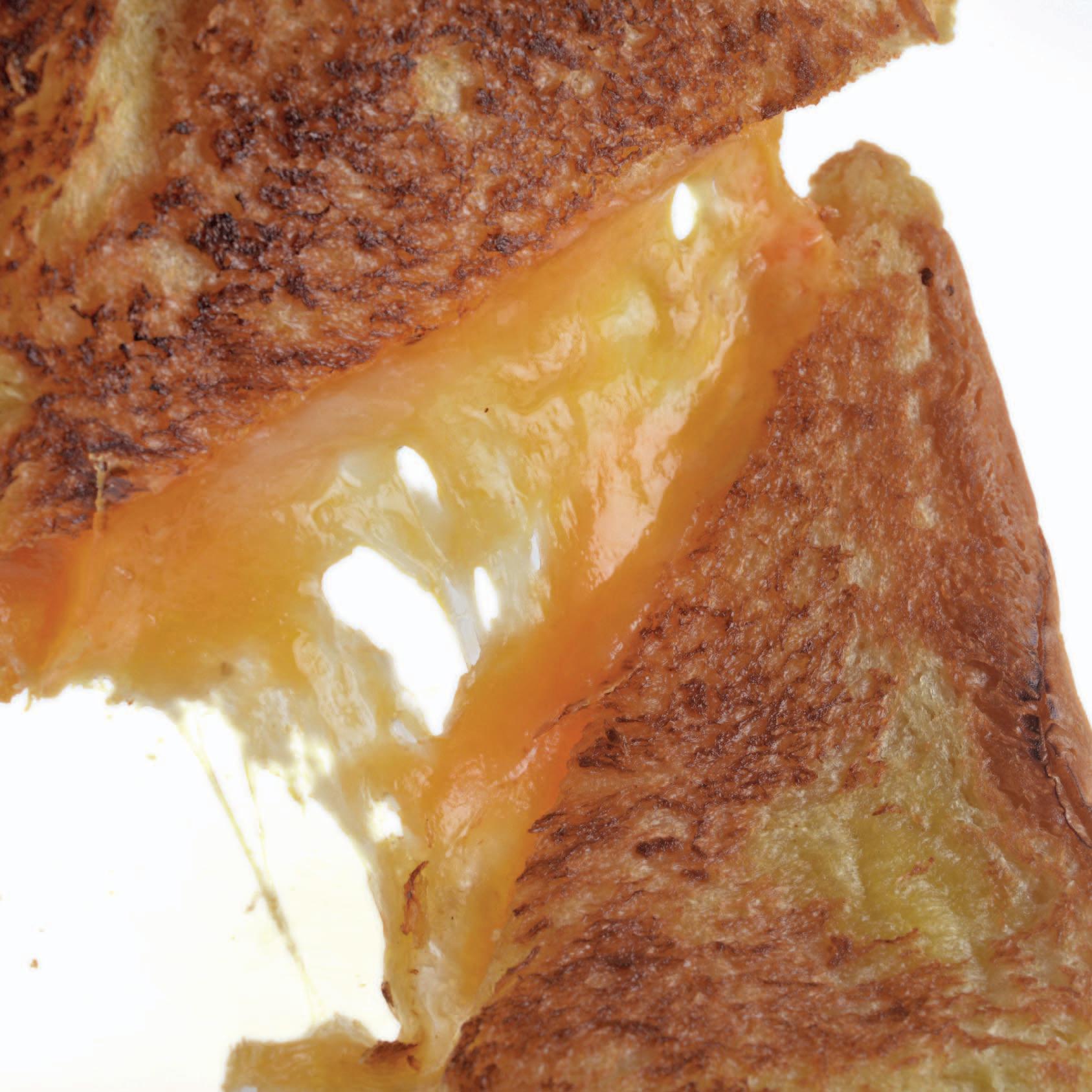
Food they’llactuallyeat
Iree’s Grilled Cheese



RECIPE COURTESY OF MAXINE SIU, PLOW
Move over, American on Wonder Bread. There’s a new grilled cheese in town. This sandwich — served at San Francisco’s Plow, a popular eatery, especially among the brunch crowd — packs as much comfort and nostalgia as the classic but takes things to the next level with two cheeses: Point Reyes toma and cheddar. All of that melty goodness sits between two slices of buttered brioche for a match made in kid-friendly culinary heaven. Add apples or sun-dried tomatoes for a little something special, and pair with a hearty bowl of tomato soup for dipping to achieve the full effect. Lunchtime won’t be the same again
INGREDIENTS
Two slices of brioche
Butter, melted
1 slice of Point Reyes toma
1 slice of cheddar
Optional
Sun-dried tomatoes
Apple
Brush
Toast
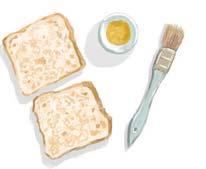
Place
Fold together, and cut diagonally To give the sandwich a little zing, add sun-dried tomatoes or thin slices of apple.
31 BAY AREA NEWS GROUP KIDS
both sides of the brioche with the melted butter
TODDLER
PHOTOGRAPH BY DOUG DURAN, ILLUSTRATIONS BY JEFF DURHAM
the brioche on one side until golden brown. Then flip the brioche.
a slice of cheddar on one piece of bread and a slice of toma on the other Cover the pan with a lid for about 1 minute.
Beach fit for a king
True, you may not find a hot dog-eating contest here, and it may not attract as many hipsters as Brooklyn, but despite all that, Alameda’s Crown Memorial State Beach once was referred to as the Coney Island of the West. These days, the beach attracts day-trippers from all over the Bay Area and offers something for just about everyone. Mom, Dad or the older sibs can windsurf or kiteboard (lessons and rentals are available on spring weekends and in the summer), while the younger ones can construct the perfect sandcastle.

For details, call 510-544-3175
Out and about
BY TOR HAUGAN
Magic of theater
If you’d like to take your kids to the theater but you know they’re not quite ready for the “Book of Mormon,” check out Fantasy Forum at the Lesher Center for the Arts in Walnut Creek. There, young thespians can take in interactive shows in a kid-friendly space. This past season featured “Wizard of Oz,” among other offerings. Fun fact: Jack Haley, the Tin Man from the 1939 film, reportedly attended a production of “Wizard of Oz” in 1978.
The Lesher Center for the Arts is at 1601 Civic Drive. For details, go to http://fantasyforum.org
Let’s bounce
If your kids are bouncing off the walls, take them to a place where it’s OK even encouraged for them to jump to their hearts’ content. San Francisco’s House of Air, one of several trampoline parks in the Bay Area, offers open jump time, as well as classes and programs for kids as young as 2 It also can host parties and other events.
House of Air is at 926 Old Mason St. in San Francisco. For details and tickets, go to www.houseofair.com.
Their natural habitat
Want to take the tykes to a place where they can play and learn? Check out Habitot Children’s Museum, in downtown Berkeley Toddlers will love all of the hands-on fun crammed into a relatively small space. Kids can explore the Wiggle Wall, a vertical maze of tunnels; check off items on their shopping list at the scaled-down pretend grocery store; and explore the Waterworks area, where they’ll discover the unique properties of the most abundant liquid on Earth.
Habitot Children’s Museum is at 2065 Kittredge St. For details, call 510-647-1111
Aday on the farm
Do you want to experience farm life without doing heavy labor? At Deer Hollow Farm in Rancho San Antonio Open Space Preserve, visitors can take selfguided tours of the 10-acre working farm, and young ones will enjoy looking at the livestock. On mornings of the third Saturday of the month, the Deer Hollow Farm Nature Center, in the old apple shed, is open to the public, and a Friend of Deer Hollow Farm docent is on hand to answer questions.
Deer Hollow Farm is at 22500 Cristo Rey Drive. For details, call 650-903-6430.
32 KIDS BAY AREA NEWS GROUP TODDLER
RA Y CHA VEZ


 ILLUSTRATION BY KEITH NEGLEY
STORY BY JON WILNER
PHOTOGRAPHS BY JIM GENSHEIMER
ILLUSTRATION BY KEITH NEGLEY
STORY BY JON WILNER
PHOTOGRAPHS BY JIM GENSHEIMER
As grade schoolers better engage in cooperative play, sports and activities definetheir dailylives andidentities
S TAT E O F
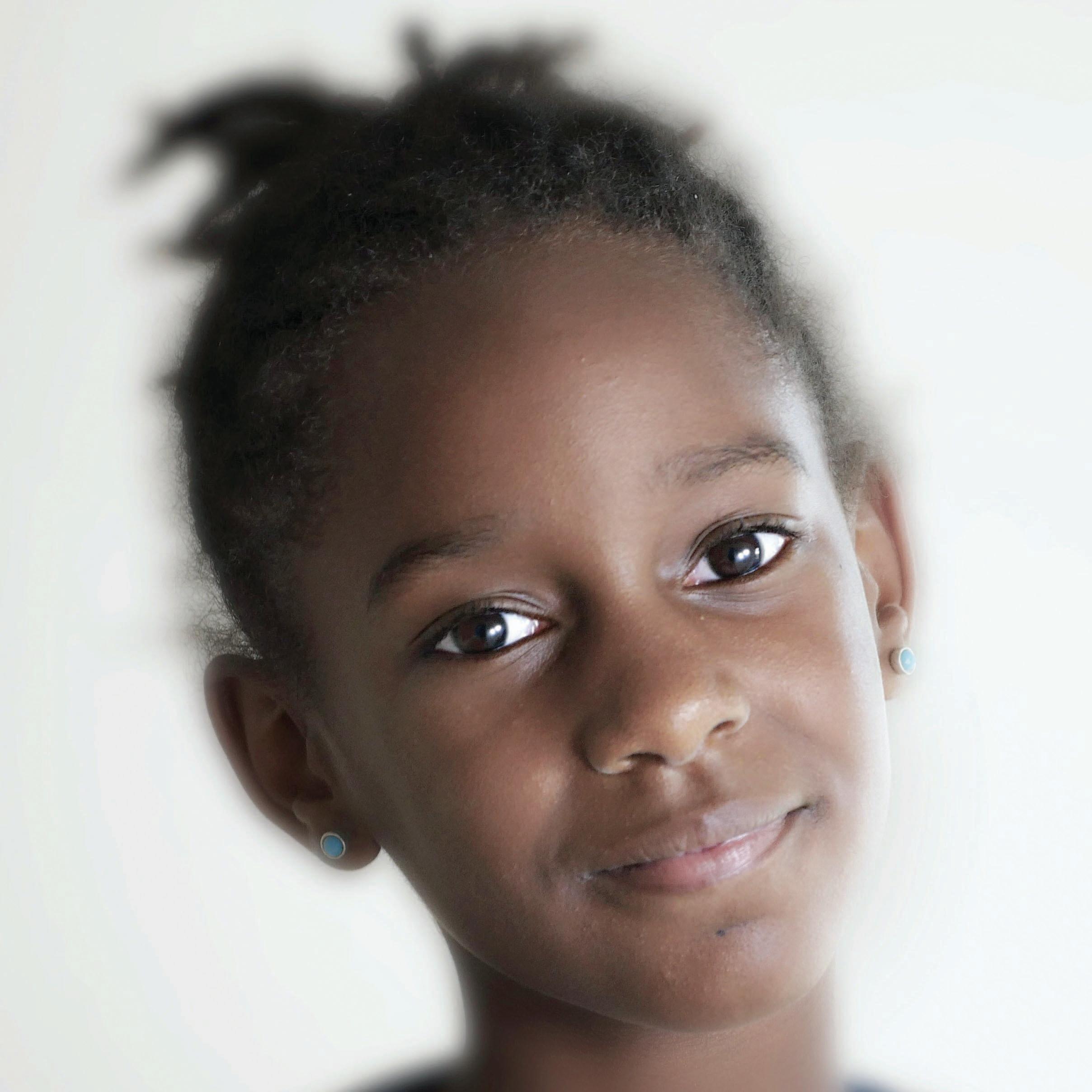
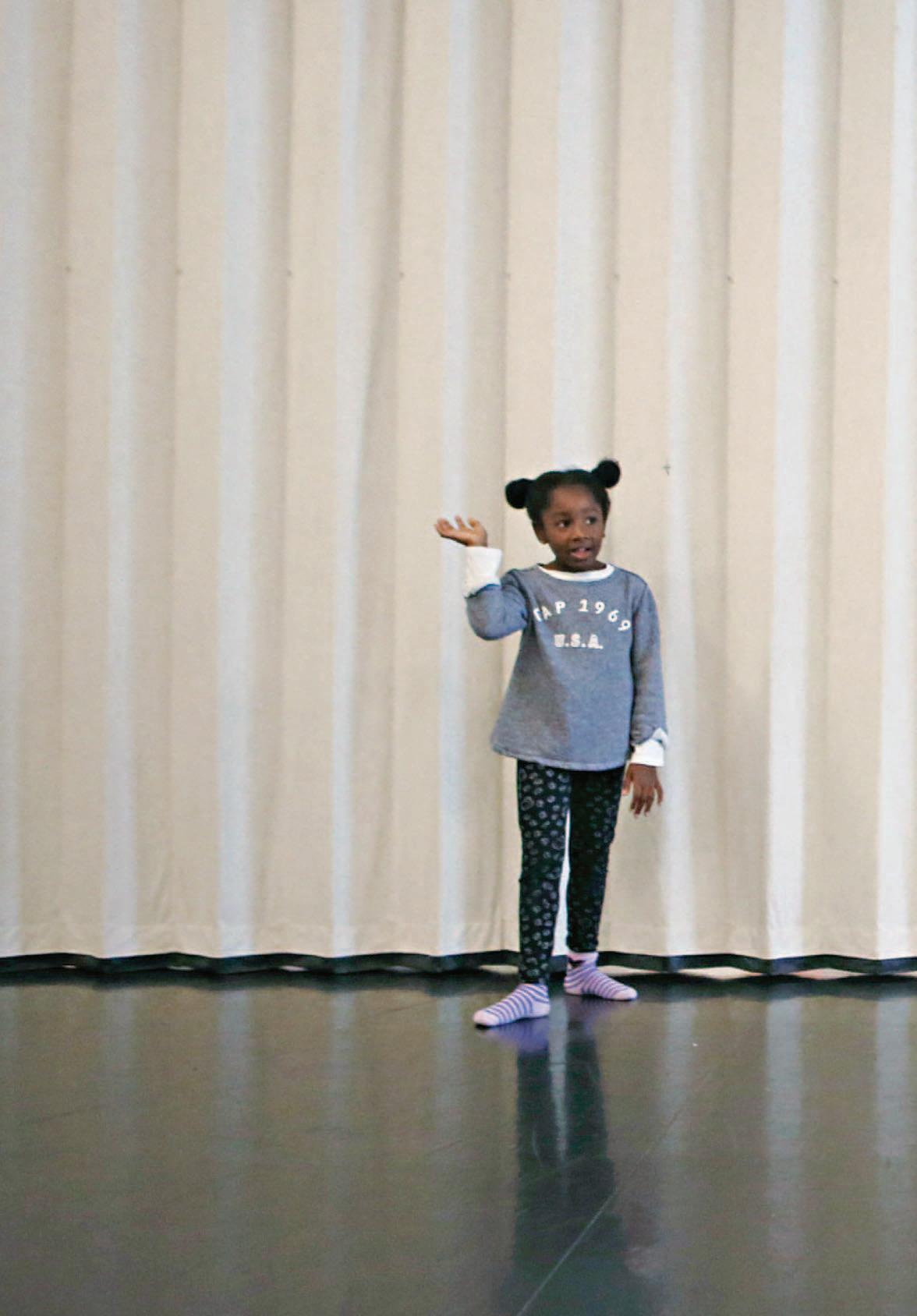
36 KIDS BAY AREA NEWS GROUP
“They begin to compare their ideal self to their actual self.Thatcan lead to good self-esteem and hard work, or toafeeling of helplessness.”
EMILY SLUSSER, ASSISTANT PROFESSOR FOR CHILD AND ADOLESCENT DEVELOPMENT AT SAN JOSE STATE
Bronwyn Brantley enjoys running track almost as much as she enjoys swimming Swimming is the best, of course, aside from chess There’s nothing better than chess well, except ballet. Ballet beats chess and everything else in Bronwyn’s busy life.
Just a few weeks ago, in fact, the 7-year-old went for her annual checkup. The pediatrician asked about her activities Bronwyn mentioned ballet.
“Tell me about it,” he said. She had no intention of telling him about it.
“Let me show you,” she said. With that, the Oakland native unleashed her best Misty Copeland impression — smack in the middle of the tiny exam room.

“She’s eager to show what she can do,” says Bronwyn’s mother, Helena. “She can see her own progress, and it seems to have emboldened her”
Bronwyn isn’t alone. She’s like millions of other elementary school children for whom activities are an essential part of their daily lives.
Is this thirst for action — through sports or music, art or dance — an instinctive desire to carve out an identity separate from those of their parents and siblings?
Is the explanation even simpler, rooted in nothing more than the urge to have fun?
From an evolutionary standpoint, taking part in sports and activities can be traced back millions of years, when socializing became necessary for early
Bronwyn Brantley, 7, pictured here and on the opening page, dances with her sister, Avery, 5, at Oakland School for the Arts. “She’s eager to show what she can do,” says Bronwyn’s mother, Helena.
37 BAY AREA NEWS GROUP KIDS
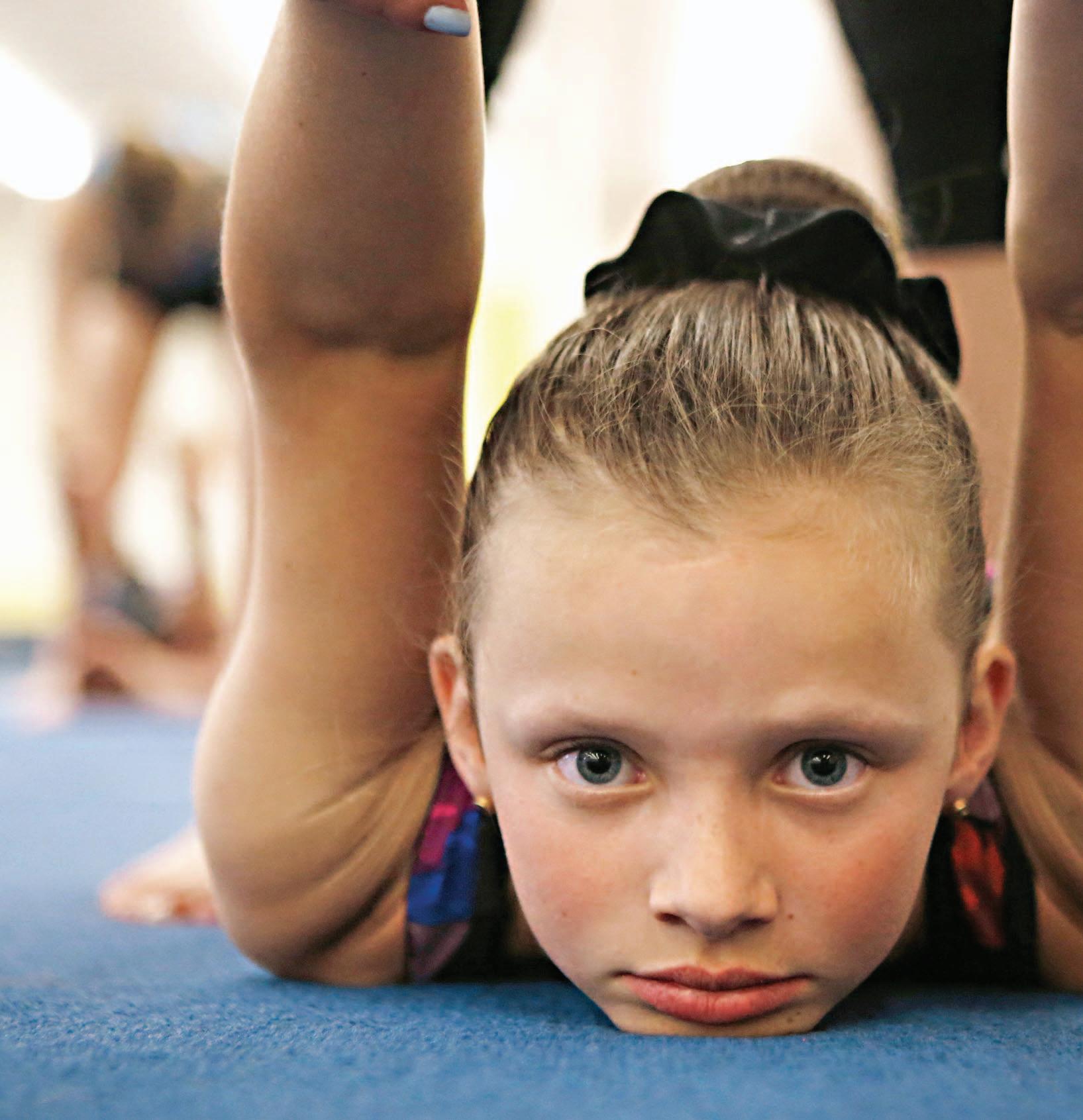
human survival.
But what does it mean in the age of iPhones and Xboxes?
Unfortunately, the research is a tad thin for ages 6 to 11, or what experts call middle childhood. This time lacks the breathtaking developmental leaps that dominate infancy and toddlerhood and is devoid of the drama that comes with adolescence. For every five books on infants, toddlers and teenagers, there is one on middle childhood.

“It’s the mellow period,” says San Jose State professor Maureen Smith, who specializes in child and adolescent development. “It’s an incremental adding of skills.”
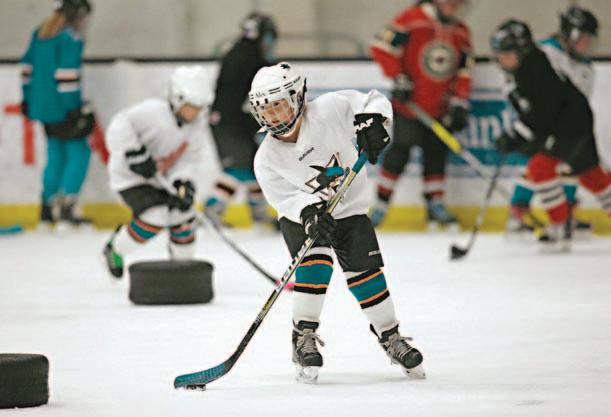
MIDDLE CHILDHOOD ALSO IS the age when social comparison takes root. Toddlers are the center of their own world, with attributes painted in broad strokes: They are the fastest, the smartest, the strongest.
The transition into grade school brings a cognitive advance that allows for perspective: Joey learns he isn’t as fast as David; Emily discovers she’s smarter than Nicole but not as smart as Caitlyn.
Confidence, or lack thereof, is sure to follow
“They begin to compare their ideal self to their actual self,” says Emily Slusser, who has a doctorate in psychology and teaches at San Jose State “That can lead to good self-esteem and hard work, or to a feeling of helplessness.”
The development is best expressed by what experts call the theory of mind, which explores how children in elementary school become capable of differentiation: They’re able to grasp that other kids think, feel and act differently than they do
“The theory sets the roots for empathy and moral reasoning,” Slusser says. “That opens you up to other experiences, and you’re able to engage in more coopera-
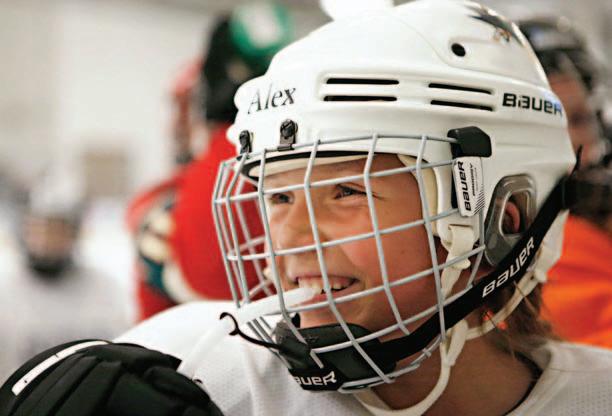
39 BAY AREA NEWS GROUP KIDS
Above: Alex Gravink, 9, participates in ice hockey practice at Sharks Ice in San Jose.
Left: Her sister, Ansley, 10, has her arms stretched at San Jose’s ATA Gymnastics.
tive play — like sports.”
For a long time, experts believed self-esteem was the chief building block for success. Turns out, it’s the other way around: Success creates self-esteem, as the Gravink family of San Jose has come to realize
ANSLEY GRAVNIK, 10, HAD A knack for “hanging on stuff” as a young child, according to her father, Eric. One day in second grade, she came home from school able to do cartwheels She enrolled in a gymnastics class, and within six months was asked to join the acrobatic team. She now spends 12 to 14 hours a week at the gym and travels to competitions across the country.
Alex, 9, her sister, wasn’t as natural in the gym, but she was exposed to hockey at a Sharks Ice event for girls and took an immediate liking. Now Alex plays for the Junior Sharks and
“Unstructured free time — daydreaming is how we find out identity. You stare at the cloud and think, ‘What do I want to be?’” San Jose State professor Maureen Smith says.
during the season spends up to five hours per week on the ice When possible, she also helps coach.
“We don’t compare one to the other. Each has her own thing, and they’re in completely different sports,” Eric says. “The only rule we have for any activity is that if you sign up, you have to stick it out to the end of your commitment.”
The sisters’ confidence has skyrocketed since they became immersed in their respective sports. Ansley set a school record for situps and has been known to take on the boys in pushup contests. Alex wants to be the first female player in the NHL
“She’s recognized her progress,” Eric says, “and it’s motivated her”
Helena and Todd Brantley have noticed a similar trajectory with Bronwyn. One recent night at dinner, she noticed — and corrected her mother’s posture.
“In ballet,” she told her parents, “we learned that you have to sit up.”
In the year since Bronwyn transferred to a smaller, more structured class at the Oakland Ballet Company, she has felt more comfortable with her body and more determined not only with ballet but with everything in her life. “She wants to get it right,” Helena says.

This spring, the Brantleys cut back on Bronwyn’s activities and began scheduling more one-onone play dates. The concerns about overcommitting her were justified: Too much too often is one of the pitfalls when children begin to take an interest in sports and activities.
They can’t self-regulate, so it’s up to the parents.
“Overscheduled kids lose the value of free play, whether it’s playing with Barbies or climbing a tree,” says Smith, the San Jose
State professor. “Unstructured free time — daydreaming is how we find out identity You stare at the cloud and think, ‘What do I want to be?’ ”
Another issue around sports and activities during elementary school can carry significant longterm consequences, and it runs counter to the parental instinct to protect: Performance is so closely monitored that children often aren’t allowed to fail.
“Failure is actually good for kids,” Smith says. “It builds resilience and an ability to cope: I can’t play basketball, but I can swim fast.
“We spent decades insulating our kids from failure, and the result is that we have 18-year-olds who crumple [at the first sign of adversity]. You don’t have to be good at everything.”
But it sure is fun trying
40 KIDS BAY AREA NEWS GROUP
JWILNER@BAYAREANEWSGROUPCOM
Bronwyn Brantley acts silly as she creates a dance routine.
Do it yourself
Worm bin
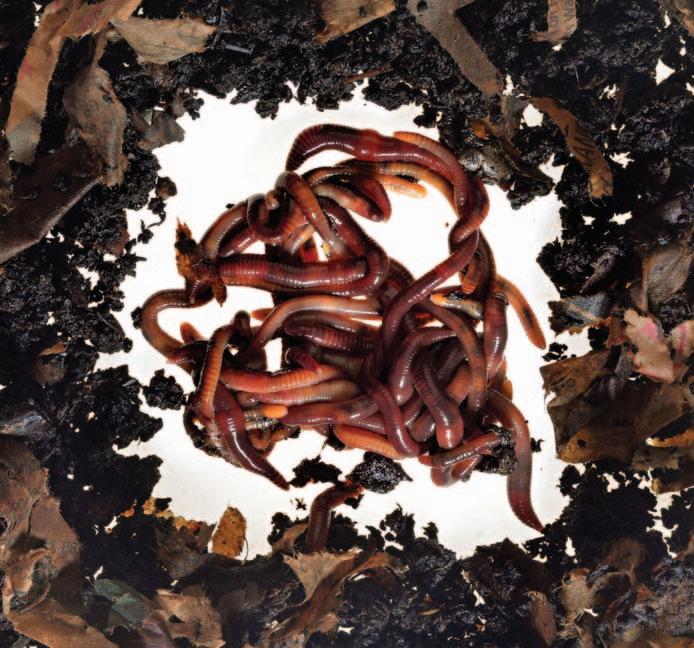
PROJECT COURTESY OF CHILDREN’S MUSEUM OF SONOMA COUNTY, SANTA ROSA
This activity is not only fun and interesting, it’s also sustainable and extremely practical. The worm bin project is from the Children’s Museum of Sonoma County, which is a destination for North Bay families wanting to steep their young ones’ minds in the arts and sciences. Don’t throw those food scraps away toss them into the container, where the slimy little crawlers help convert uneaten waste into nutrient-rich compost. Feed your worms a vegan diet — don’t give them meat, fish or dairy. Check the composter every few days, and harvest when it smells like a fresh forest (usually after three–five months).
MATERIALS
Dark plastic 10-20 gallon storage box, 2 lids for box, newspapers, 1 quart soil from the garden, 1 gallon water, red wiggler worms (Eisenia fetida), brightly colored tape, 2 craft sticks
PROCESS
Drill 20-25 ¼-inch drainage holes in the bottom of the box, two rows of 1⁄16-inch ventilation holes near the top and 30 1⁄16-inch holes in the lid. Shred newspaper, moisten until damp and fill the box 2⁄3 full. Add soil. Tuck worms into the middle. Cover with bedding. Put second lid under bin to catch drips,
which can be poured back into composter Make an X-shaped marker with tape, craft sticks. Place kitchen scraps in a hole in the corner, cover with bedding with marker on top. When the scraps are mostly gone, add more. Put them to the right of the first batch, move the marker and continue like this clockwise
41 BAY AREA NEWS GROUP KIDS GRADE SCHOOLER
DOUG DUR AN
PARENTS’ BIGGEST FEARS
ESSAY BY CHUCK BARNEY ILLUSTRATION BY MARIE ASSÉNAT
One moment he was there. The next, he was gone. We were vacationing at the Disneyland Hotel when David, then 5, raced to the elevator trying to be the first to push the button. One problem: He didn’t wait for us. The elevator doors closed, and he was whisked away to who-knows-where. Immediately, we split up and searched various floors. And after David didn’t show up for what seemed like forever, parent-noia set in: Had our boy been abducted? It didn’t help that my wife, Diane, and I were journalists routinely exposed to terrible stories. We were conditioned to think the worst, even though the tragedies we read about are extremely rare. In those early school-age years, you feel helpless at times. Your child is growing more independent. You’re not always there to hold his or her hand. “Stranger danger” becomes a thing, and fleeting moments of uncertainty — losing sight of your kid in the grocery store or in an unfamiliar place can send you into high alert. We’re hard-wired to keep our children safe. When kids are in danger, parents will do whatever it takes to help them. So, given our deeply ingrained need to protect our young ones, the momentary panic that sets in when we think our kids might be in danger makes perfect sense. Fortunately, the elevator terror at the hotel didn’t last as long as it felt. A group of young tourists found David and guided him back to us. Our faith in mankind was restored — along with our ability to breathe.
42 KIDS BAY AREA NEWS GROUP GRADE SCHOOLER
AND L I T T L ES T

43 BAY AREA NEWS GROUP KIDS
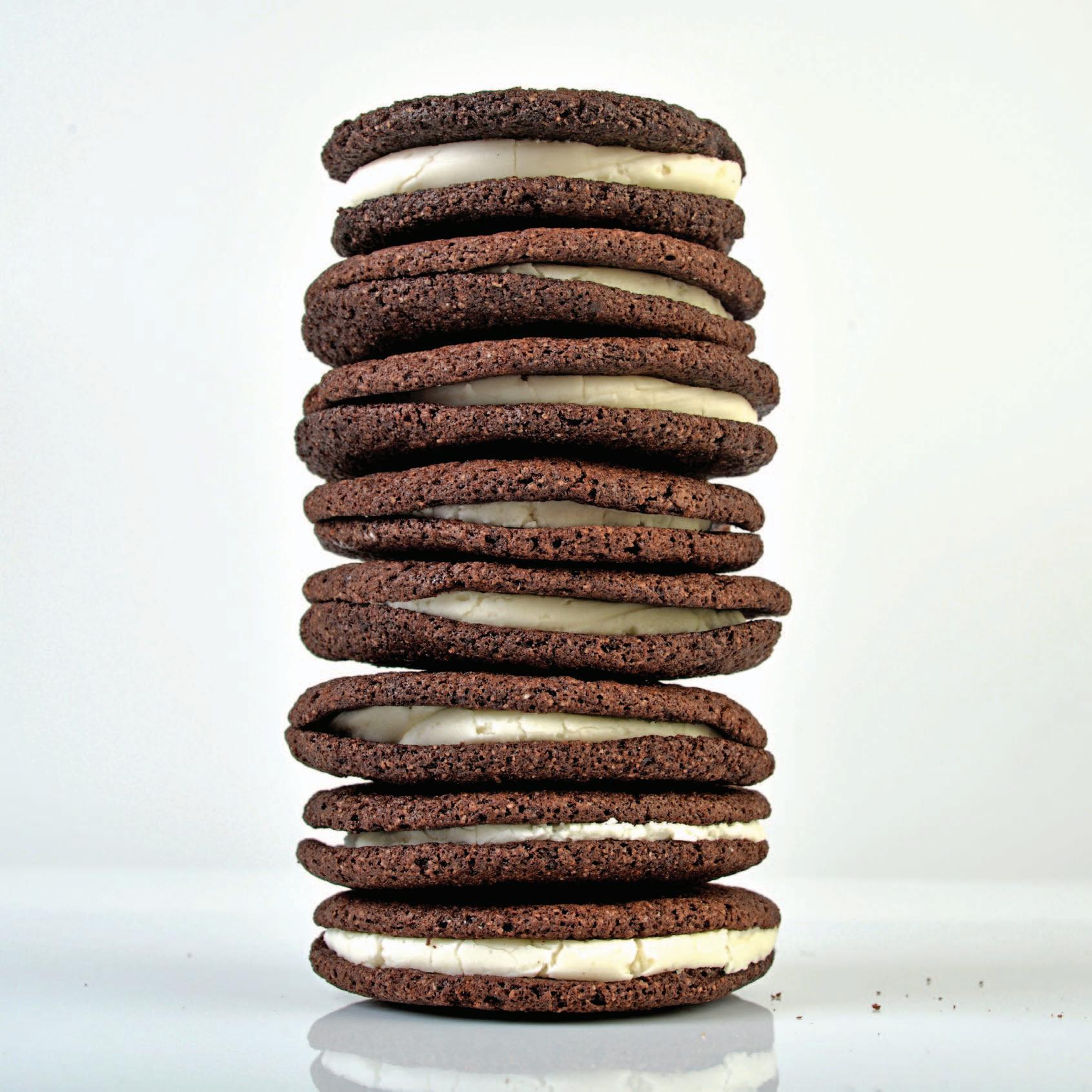
Food they’llactuallyeat
Homemade Oreos
RECIPE COURTESY OF REESE LICHTENSTEIN, HOMEROOM
The classic Oreo as a childhood favorite is nothing new. But these treats are something else altogether. Oakland’s Homeroom has developed quite the following, owing largely to its classic mac and cheese and various riffs on the schoolkid staple. But one bite of these whoopie pie-esque confections will make you realize this joint is more than just a purveyor of pasta. Those stale, prepackaged snack cakes we won’t mention any names have nothing on this delicious dessert. Pop one or two in your kids’ lunchboxes, and they’ll be the envy of the schoolyard. Just make sure you don’t eat them all yourself first.
INGREDIENTS
Chocolate cookies
1¼ cups all-purpose flour
1½ cups granulated sugar
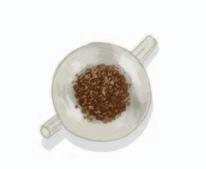
½ cup cocoa powder

1 teaspoon baking soda
¼ teaspoon baking powder
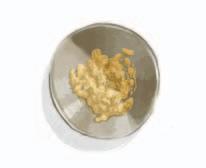
¼ teaspoon table salt

½ cup plus 2 tablespoons
unsalted butter, at room
temperature
2 large eggs
2 teaspoons kosher salt or flaky sea salt, for topping

Vanilla filling
Preheat the oven to 375 F
Combine flour, sugar, cocoa powder, baking soda, baking powder, salt.
Mix
Still on low, add ½ cup plus 2 tablespoons butter, eggs.
¼ cup unsalted butter, at room temperature
¼ cup vegetable shortening

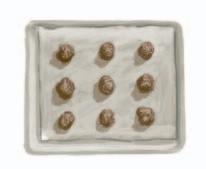
2 cups sifted confectioners’ sugar

2 teaspoons pure vanilla extract
To make the filling, blend butter, vegetable shortening.
Slowly add confectioners’ sugar, pure vanilla extract
45 BAY AREA NEWS GROUP KIDS
SCHOOLER
GRADE
Arrange on baking sheet lined with parchment paper Sprinkle with flaky sea salt. Bake at 375 F for about 6 minutes.
on low
Blend until the mixture resembles sand.
Build the cookies. Pipe a layer of filling around the edge of bottom cookie. Add a dot in the center Place top cookie.
PHOTOGRAPH BY DOUG DURAN, ILLUSTRATIONS BY JEFF DURHAM
Art meets nature
Art and nature intertwine at the Presidio National Park in San Francisco. Check out Wood Line, which runs parallel to the Lover’s Lane trail Wood Line is a work of art by Andy Goldsworthy, who also created Drawn Stone, a crack that starts in the roadway and ends at the entrance of the de Young Museum. Wood Line, made of eucalyptus trees that were removed for park projects, winds along the ground and is more than 1,200 feet long. If it’s 11 a.m.-4 p.m. on a Sunday or 5-9 p.m on a Thursday, take the kids to Off the Grid at the Presidio afterward for some top-notch street eats

Out and about
BY TOR HAUGAN
Not-so-single ladies
Here’s a fun fact: Many entomologists prefer the term ladybird beetles (or lady beetles) over ladybugs, since the insects aren’t true bugs. But they are, apparently, true ladies To see the red-andblack beauties up close, take a low-key hike in Redwood Regional Park in the Oakland hills in winter, when the area is teeming with the bugs — er, insects. The little guys have been spotted on the Stream Trail between Prince Road and Tres Sendas, and on the French Trail between Tres Sendas and West Ridge Trail.
Not that Rock City
No, you won’t see any abandoned automotive plants or aging rock stars made up as cats or starmen in this Rock City What you will see is stunning rock formations hewn from the elements over the course of many years. Young ones will have a blast as they turn into tiny explorers at this spot, located in Mt. Diablo State Park. Visitors can get to Rock City by hiking from the park’s south entrance and following the Summit Trail. Rock City is just a short walk past the Live Oak camping area.
For details, call 925-837-2525
Aplayground for everyone
Kids of all abilities play alongside one another at Matteo’s Dream. The playground, at Concord’s Hillcrest Park, was funded and built largely by volunteers, who helped turn the dream of Concord resident Liz Lamach, who spearheaded the project, and her son into reality. Lamach’s son, who uses a wheelchair and is blind, is the park’s namesake.
The playground, fun and accessible for all children, is at 2050 Olivera Road.
Petit artiste
At this stage, your little one’s artistic creations might be more in line with the style of Jackson Pollock than that of Vincent van Gogh. Whether you have an abstract artist or an impressionist on your hands, check out the East Bay’s awardwinning Richmond Art Center, where kids from preschool age on up can explore their inner artist and express themselves in a variety of creative ways.
Richmond Art Center is at 2540 Barrett Ave For details, including information about classes, call 510-620-6772.
46 KIDS BAY AREA NEWS GROUP GRADE SCHOOLER
ARI C CR ABB

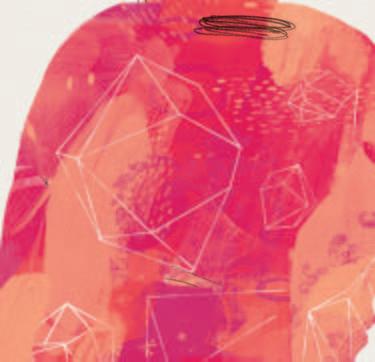 ILLUSTRATION BY KEITH NEGLEY
ILLUSTRATION BY KEITH NEGLEY
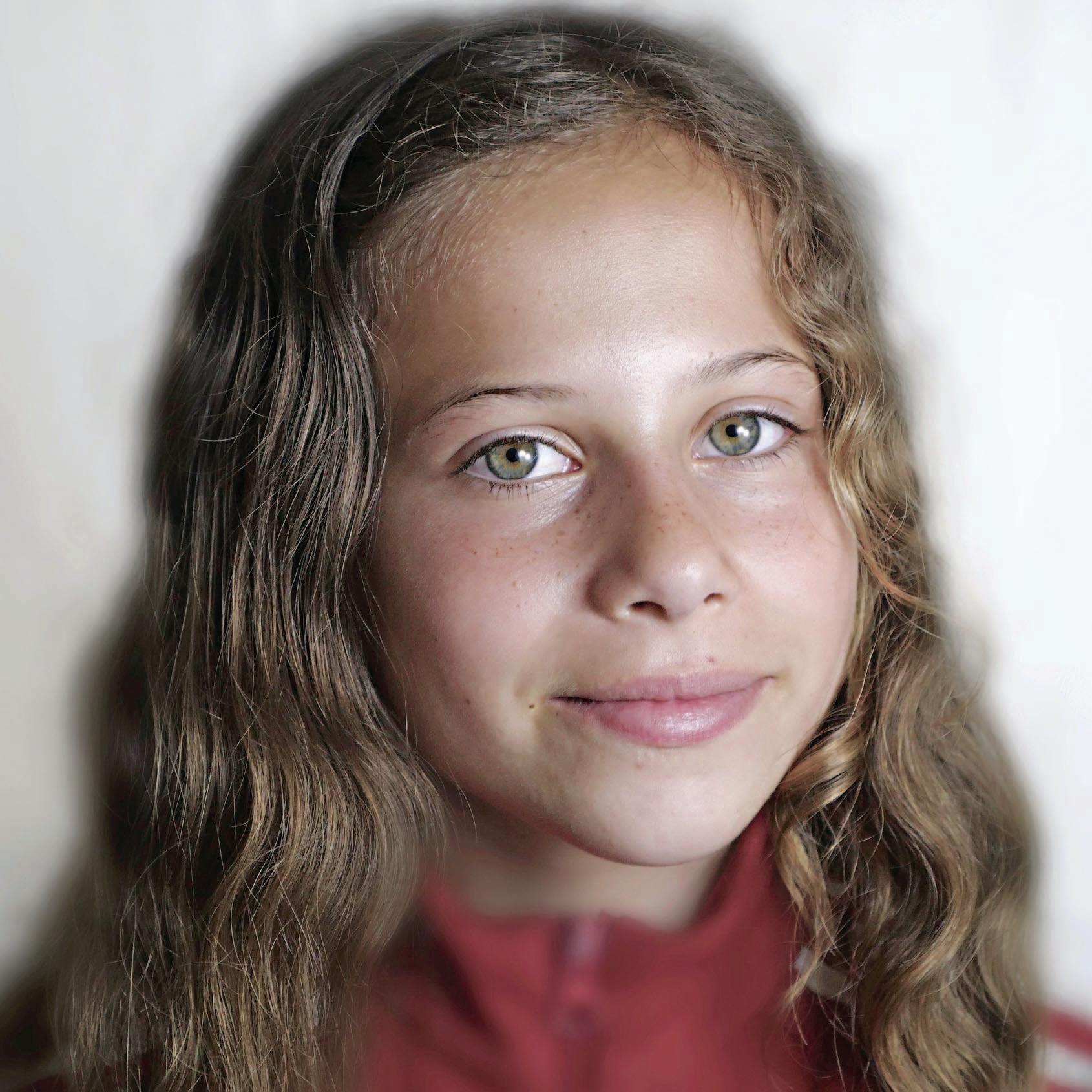
TWEEN spirit
Are the tween years as awkward as popculture suggests?Kidssay no, andthink that thestereotypemay stem from adults’misunderstandingof theage.
STORY BY KAREN D’SOUZA
PHOTOGRAPHS BY JIM GENSHEIMER

50 KIDS BAY AREA NEWS GROUP
“Sometimes I wish thatIcould be older becauseI feellike Iamon theedge of beingakid,and Iwanttobemore sophisticated.”
SOPHIA KLEIN, 10, OF OAKLAND
Too old for Play-Doh and finger paint but too young for angst or rebellion. Still little enough to scoop up in your arms but far too big to put up with the indignity
Welcome to the realm of tweendom, those in-between years when kids — and their parents often feel unsure of how to proceed.
Movies and television (remember “Lizzie McGuire”?) usually portray this tender time as awkward, full of braces, cringing and middle school drama. While some young people may bask in the glow of finally hitting double digits, others find the tween years often described as ages 10 to 12 as long indeed.
Either way, many who are actually part of that demographic don’t exactly embrace the term “tween.” Sophia Schilb, for one, doesn’t like to be defined by labels. The San Jose 12-year-old thinks the whole concept is just a silly stereotype made up by the media.
“I don’t think I’m a tween. I think I’m me,” Schilb says. “I’m a kid.”
Others believe the tween years are perceived to be awkward largely because of society’s expectations.
Sophia Klein, for example, says that she and her BFFs often put on airs and act older than they are to make other people feel more comfortable
“My friends and I act like we’re older to avoid it being awkward,” says the bubbly Oakland 10-yearold with her own YouTube channel, dubbed SophiaSwag 101,

51 BAY AREA NEWS GROUP KIDS
Sophia Klein, 10, pictured here and on the opening page, works on a Mother’s Day card in her room as the neighbor’s dog, Rudy, sits on her lap at home in Oakland.
where she regales viewers with tales of beauty, art and cuteness. “But sometimes I wish that I could be older because I feel like I am on the edge of being a kid, and I want to be more sophisticated.”
Her mother, Lisa Beyer, agrees.
“The awkward tween seems mostly a cliche to me these days, although I recall feeling and being very awkward when I was Sophia’s age,” Beyer says. “Sophia and her cohorts really don’t seem awkward in their intellect, behavior or appearance. There can be awkwardness, however, in how we adults interact with tweens, finding the right (or wrong) spot on the kid-to-teen spectrum in various situations”
DEFINING WHO YOU ARE
when your identity is in flux can be tricky Schilb says the best way to avoid feeling like you don’t fit in is to be fully engaged in life.
“I like to be up and about. I don’t like to be sitting around staring at a phone. I don’t even have a phone,” she says, sitting cross-legged on a chair. “I have lots of things to do.”
While some kids may feel overbooked with all the various “enrichment” activities children are expected to take part in these days, be they sports or clubs or volunteer work, Schilb says staying active keeps her from getting stressed out. This way, too, she doesn’t have all her eggs in one basket
“It helps to be part of things that are bigger than you,” she says “I’m so involved in my extracurriculars, I don’t get sucked into all the drama at school.”
For her, that means dividing her off time between soccer, theater and dance She’s an old hand at Children’s Musical Theater San Jose, where she has performed in eight shows over the years Her experience there has helped her

52 KIDS BAY AREA NEWS GROUP
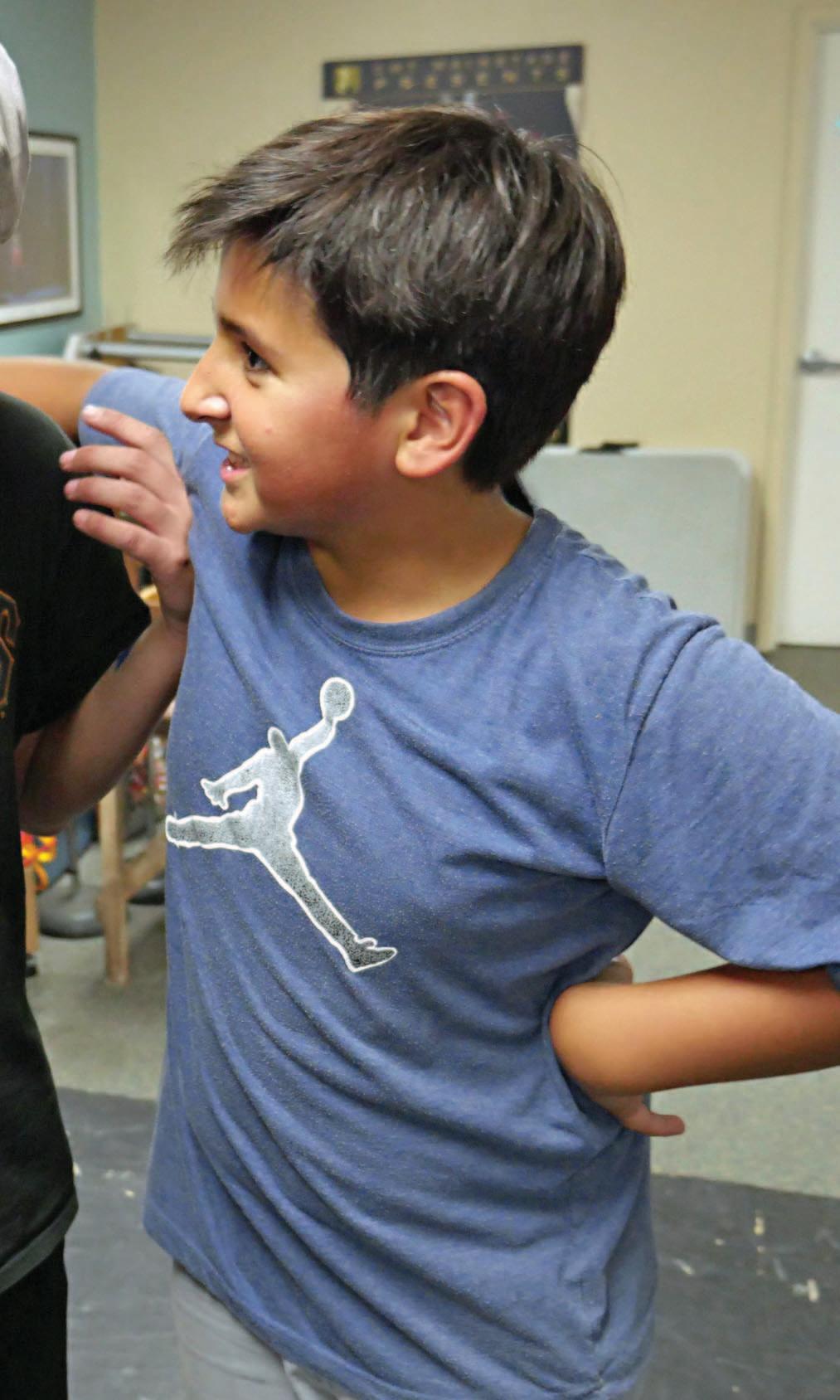

53 BAY AREA NEWS GROUP KIDS
Above: Armando Gonzalvez, 12, center, practices a dance routine for the musical “Crazy for You” at Children’s Musical Theater in San Jose. Left: Armando, 12, right, talks offstage with Miguel Bayon Jacobson, 12, left, and Jared Weinstock, 14.
acquire poise and focus she can apply to other parts of her life.
“For me, it’s a way to have more connections and to have more people who get you,” she says “Having confidence really helps you feel better.”
THAT MAKES A LOT OF SENSE to Armando Gonzalvez. The 12-year-old from Cupertino wisely points out that tweens aren’t the only ones who can have a tough time figuring out who they are Learning and growing can be confusing no matter if you are 14 or 40.
“As far as I can tell, lots of people feel awkward for one reason or another,” says Gonzalvez, who is fond of theater and filmmaking He says he feels comfortable with who he is right now, and he’s not worried about being someone else. He’s certainly in no rush to start high school, because he’s heard the homework load is intense.
“I’m a kid. I’m a boy. I like video games,” says Gonzalvez, a glint of mischief in his eye.
Tweens have a lot of different ways of coping with life’s bumps. Klein gets a lot of joy from playing soccer, and she turns to her parents for comfort. “My parents make me feel better,” she says, “so I like to go to them.”
Klein also offered some words of advice for younger kids who may be anxious about entering their tweens.
“I would tell them to never give up, because everyone around their age might be going through the same thing ”
KDSOUZA@BAYAREANEWSGROUPCOM
Sophia Klein hugs her mother, Lisa Beyer, at their home in Oakland “My parents make me feel better,” Sophia says, “so I like to go to them”

54 KIDS BAY AREA NEWS GROUP
Do it yourself
Wind-powered contraption
PROJECT COURTESY OF THE TECH MUSEUM OF INNOVATION, SAN JOSE
Have an aspiring engineer in the family? This project will surely put the wind in her sails. In this activity, provided by the Tech, the award-winning destination in San Jose where innovation and education converge, your kid makes a contraption — with sails that can capture the wind power of a fan that can carry a load. Any materials will work, but encourage your child to be creative, whether that means using a milk carton as the body or a piece of fabric as a sail. Keep in mind that it may take some time to assemble the vehicle — just remember that trial and error is part of the fun. (Hint: If the vehicle is a bit unsteady, try adding some weight.)
MATERIALS
The vehicle can be built with whatever items you have around the house. Here are some ideas. For the body of a vehicle: fry baskets, strawberry baskets, paper cups, pipette trays, to-go food containers For a sail: cardstock, cardboard scraps, recycled paper, foam sheets. For wheels: cardboard tubes, CDs,
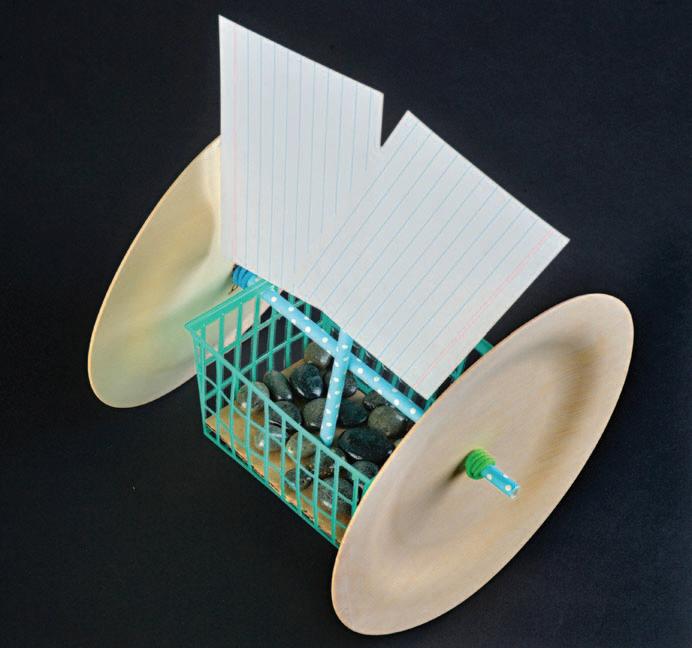
bottle caps (with pre-drilled center holes), plastic lids, paper plates To provide structural integrity for sails or for wheel axles: straws, craft sticks, chopsticks For fasteners and fixers: masking tape, twist ties, string, rubber bands. For weight or balance: reclaimed scrap plastic parts.
PROCESS
First, gather your materials. Next, set up your testing area. Find a spot that has a smooth surface, and place a fan at one end of your track and a finish line at the other Then build your vehicle. Test and retest until you have created a contraption that glides
55 BAY AREA NEWS GROUP KIDS TWEEN
DOUG DUR AN
L I T T L ES T
PARENTS’ BIGGEST FEARS
ESSAY BY CHUCK BARNEY ILLUSTRATION BY MARIE ASSÉNAT
When David entered junior high, all the “cool” kids played sports and wore jerseys of their favorite teams. Being a sports maniac, I encouraged our son to go along with the crowd. But he simply wasn’t into it. Instead of wearing the Warriors jersey I bought him, he donned a fedora and vest. And instead of working on his jump shot, he got into Shakespeare. Later, when Sam hit his tween years, he too displayed a taste for the offbeat, gravitating toward heavy metal music by weird, obscure bands I fretted over our oddballs. Would other kids make fun of them? Would they fit in or would they feel alone? We want what’s best for our kids. While it is tempting to steer them in a more conventional or socially acceptable direction, resist that urge. In the effort to help our children avoid hardship, we must not deprive them of the opportunity to live their own truths — no matter what those truths are. During this stage of my sons’ lives, I had to constantly remind myself that being unique is, indeed, cool. So we embraced their differences, visiting the Oregon Shakespeare Festival and incorporating heavy metal into our road-trip playlists. I even came to admire David for not wearing his jersey
In a way, it was striking evidence that he was no mindless follower — that he was on his own path and would be immune to peer pressure along the way.
56 KIDS BAY AREA NEWS GROUP TWEEN
AND
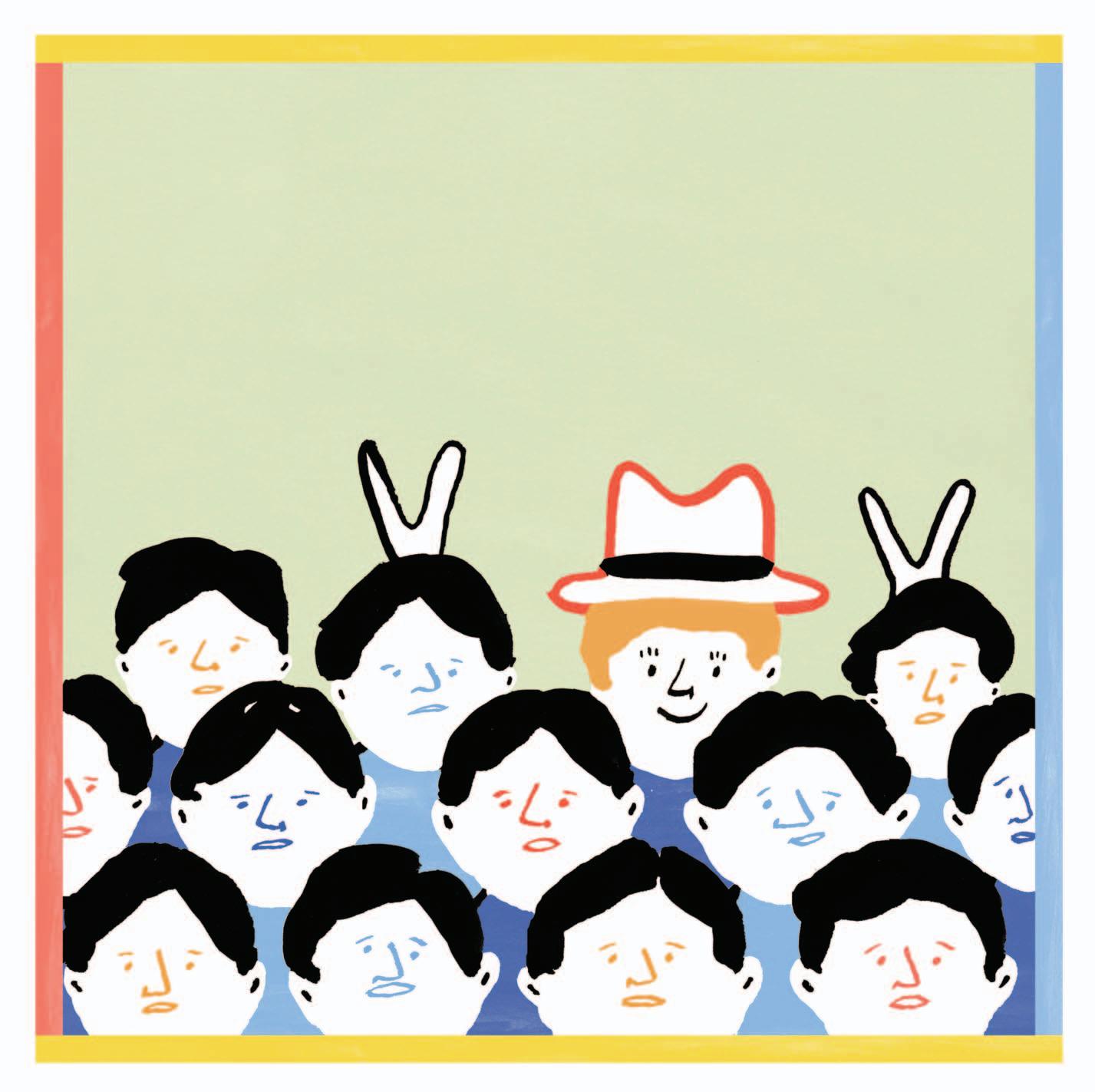
57 BAY AREA NEWS GROUP KIDS
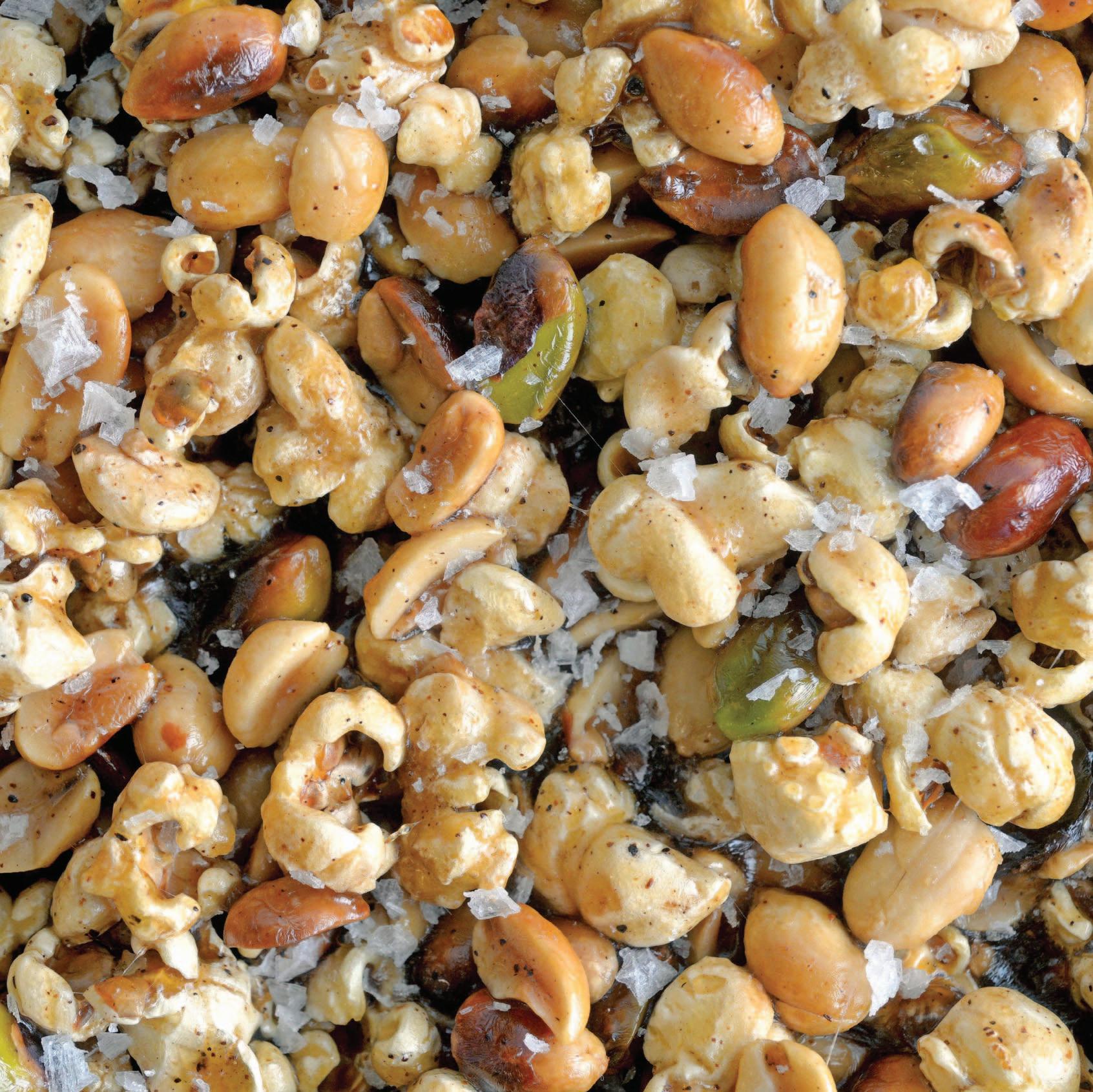
Food they’llactuallyeat
Desi Jacks
RECIPE COURTESY OF PREETI MISTRY, JUHU BEACH CLUB
The next time you take your kid out to the ballgame, whether it’s Little League or the Giants or A’s, don’t forget the Desi Jacks. This riff on Cracker Jack comes from Oakland’s Juhu Beach Club, a restaurant in the hip Temescal neighborhood that offers fresh takes on Indian street food. The snack includes peanuts and pistachios and, like Cracker Jack, has a sweet coating and packs a surprise — in this case, chili powder. The best part? The spices can be adjusted, so your little slugger doesn’t have to handle any more heat than he wants to. Adults will love to snack on Desi Jacks, too, so bring extra.
INGREDIENTS
6 quarts cooked popcorn
¼ cup ghee (clarified butter, or substitute melted butter)
1 tablespoon ground cumin




1 tablespoon red chili powder

1 cup pistachios
4 cups peanuts
2 tablespoons kosher salt
¼ cup vegetable oil
2 cups brown sugar
2 cups light corn syrup
2 tablespoons Maldon sea salt
SPECIAL EQUIPMENT
2 Silpat mats
Combine popcorn with ghee, half the ground cumin, half the red chili powder, salt to taste.

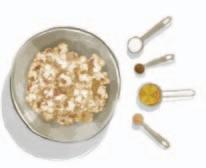
Combine pistachios and peanuts with vegetable oil, half the ground cumin, half the red chili powder, salt to taste.
Sugar thermometer
Spread on sheet pan. Roast for 10-15 minutes at 350 F, until golden brown.
On high heat, cook brown sugar, corn syrup. Stir with sugar thermometer every few minutes until mix reaches 250-268 F
Stir nuts and popcorn into caramel. Put saucepan into oven at 350 F for 10 minutes.

59 BAY AREA NEWS GROUP KIDS TWEEN
Toss.
Toss.
Flatten onto Silpat mats. Sprinkle with Maldon sea salt. Let cool. Break apart, and enjoy
PHOTOGRAPH BY DOUG DURAN, ILLUSTRATIONS BY JEFF DURHAM
Onthe water

Cool off during the hot summer months at Lafayette Reservoir The possibilities are nearly limitless. Want to fish? Take the boat out? Bike? Roller skate? You can do all of that here, and then some. Rowboats and pedal boats are available to rent at the activity center, and the area has picnic sites and a playground. The reservoir is off Highway 24, a mile from the Lafayette BART station.
For details, including information about fees and hours when bicycles, roller skates and scooters can be used, call 925-284-9669.
Out and about
BY TOR HAUGAN
High-flying fun
Looking for a top-flight educational experience for your aviationobsessed youngster?
Check out the Hiller Aviation Museum at the San Carlos Airport. The museum has dozens of aircraft, and visitors can do everything from pilot a flight simulator to operate a drone
(1-4 p.m. Saturdays and Sundays for kids ages 7 and older).
The Hiller Aviation Museum is at 601 Skyway Road For details, call 650-654-0200.
Yuk it up
There’s no need to get out of the Bay Area for high-quality comedy San Francisco’s BATS Improv (famous alums include Greg Proops of “Whose Line Is It Anyway?”) has been serving up impromptu hilarity since 1986, and, in addition to its laugha-minute unrehearsed shows, it offers youth classes, where kids as young as 11 can learn the fundamentals of improv while developing their verbal and listening skills as well as their self-confidence.
BATS Improv is at Fort Mason Center, 2 Marina Blvd., Building B. For details, call 415-474-6776.
Bowled over
They might not get your “Big Lebowski” references, but the kids will likely be on board for a trip to Pacifica’s Sea Bowl, located right along the coast The food far surpasses the standard fare found at most bowling centers. You’ll have to go elsewhere for stale chips and congealed cheese these nachos are legit To make your outing even more memorable, head to Sea Bowl for Astro Bowl night, on Fridays, because bowling is much better with lasers and glow-inthe-dark bowling balls
Sea Bowl is at 4625 Coast Highway For details, call 650-738-8190.
Kids on ice
If your kid is a future Apolo Anton Ohno or Michelle Kwan or has dreams of playing for the Sharks Oakland Ice Center is sure to become a go-to spot. With sessions for public skating and offerings including lessons for youngsters interested in hockey, curling and speedskating, there’s something here for everyone.
Oakland Ice Center, which also hosts birthday parties, is at 519 18th St. For details, go to www.oaklandice.com.
60 KIDS BAY AREA NEWS GROUP TWEEN
RA Y CHA VEZ

 ILLUSTRATION BY KEITH NEGLEY
ILLUSTRATION BY KEITH NEGLEY
THETEEN
ROLLER COASTER
Drama, passion, silence, confusion. Parents and kids struggle to navigate thehighs andlowsofthe teenageyears.
STORY BY PATRICK MAY
PHOTOGRAPHS BY JIM GENSHEIMER


64 KIDS BAY AREA NEWS GROUP
“Our kids are extensions of ourselves, and it’s very difficult for parents to separate themselves from theirchildrenand the paths they’re choosing to take.”
MICHELLE SKEEN, A PSYCHOLOGIST IN SAN FRANCISCO
It is a dance of both beautiful and baffling intensity, the almost exotic synergy between teenagers and their parents as both sides try to navigate the emotional minefield of adolescence. There is mourning and a sense of loss. There is hope and the frequent quickening of the heart.
And then, there are the hormones. Lots and lots of hormones.
Through this thicket of high drama, parents and teens wander together, often clumsily, always yin and yang. The protective guardians try to let go even as they struggle to hold on; the anxious youth, trying to forge an emerging identity, awkwardly shake off the shell of childhood and barrel like crazy people into adulthood.
“A friend of mine likened the onset of puberty to being hit by a truck — all of a sudden, everything is different,” wrote one frustrated parent on the Berkeley Parents Network, which sometimes serves as a frightening forum for parental frustration. “The good news,’’ another parent responded, “is that they do return. My sister, who teaches high school, tells mothers of her students, ‘A monster is going to take over your daughter for five years, but at the end of those five years the monster leaves and you get your daughter back’ ”
It can feel like a switch gets flipped in that 13th year Friends are in, and parents are out. Doors slam, and conversations stop. The silence is even stronger these days, now that whispered telephone gossip has been re-
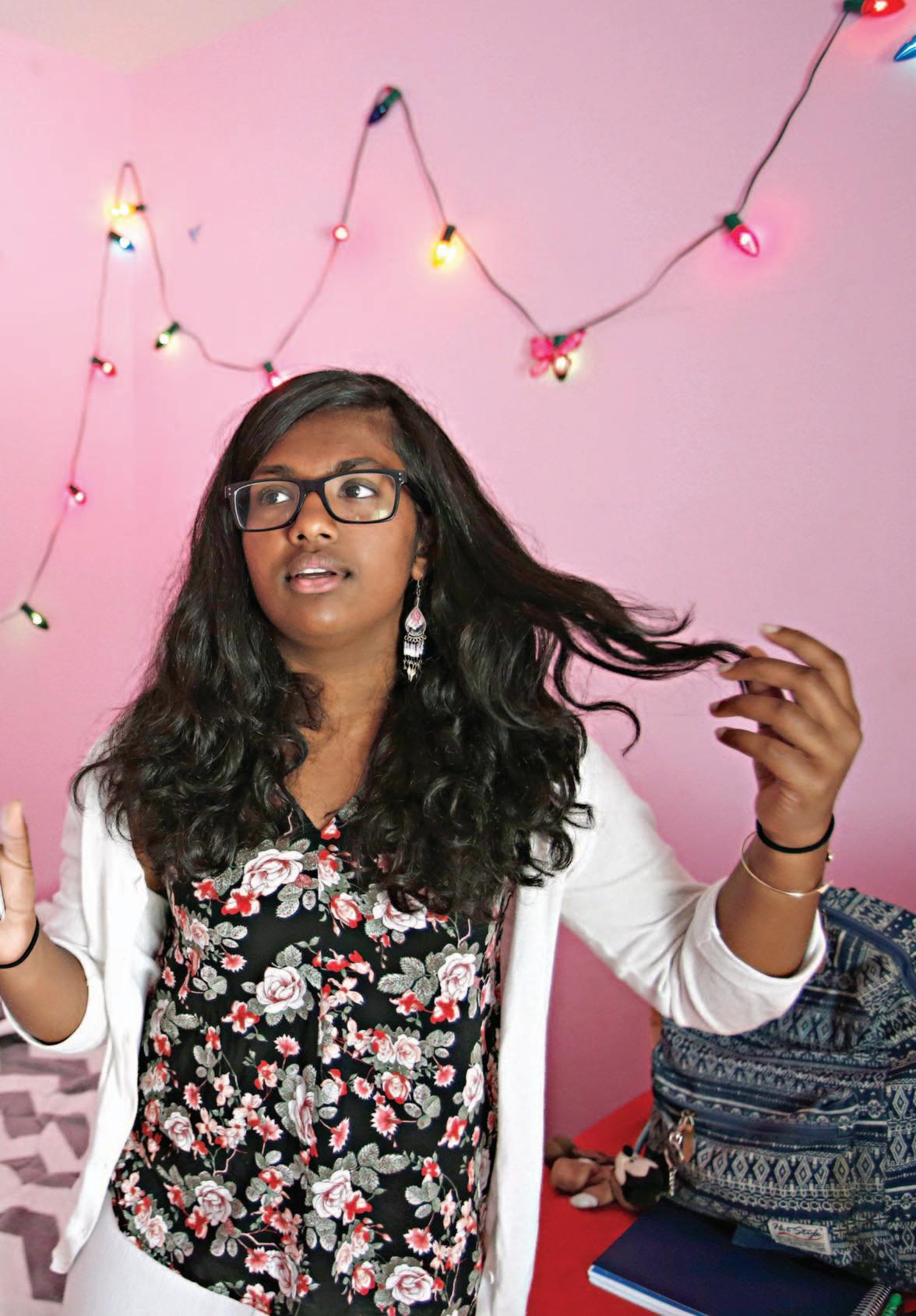
65 BAY AREA NEWS GROUP KIDS
Smarana Abbadasari, 13, pictured here and on the opening page, hangs out in her room at home in San Jose. “Thankfully, my parents know to trust me,” Smarana says.
placed by social media platforms that make it easier to go incognito: Snapchat and Facebook, WhatsApp and Kik, texting secrets late into the night
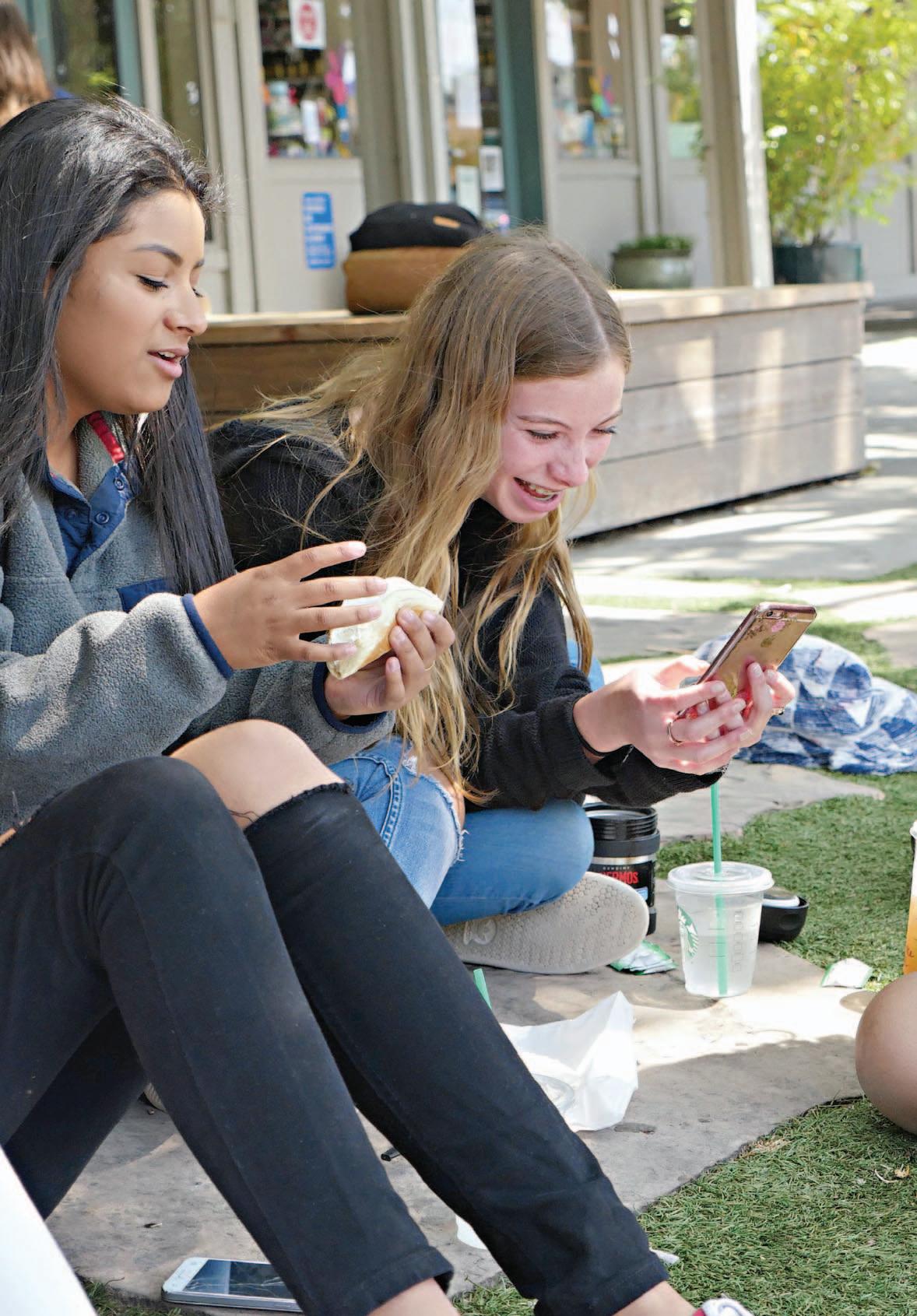
ABIJA ABBADASARI CAME
from India with her husband in 1998 to Silicon Valley, where they’re raising two kids in San Jose, including 13-year-old Smarana. She says dealing with her teens has often been “a roller coaster of emotion for me.”
She and her husband recently agreed to let their daughter have a smartphone, but it was a rocky road to reach the decision. Sometimes, such as after a recent refusal to let Smarana attend a school dance, things can get edgy and the teen-parent connection seems to short-circuit.
“She was very upset, slamming the door, crying,’’ says Abbadasari “She said to me, ‘This is the last dance at school, and I won’t see any of my friends anymore.’ It was a lot of drama.’’
For her part, Smarana says that while she and her parents “are pretty open with each other, I do talk more to my friends because they’re my age. There’s a difference between friends and parents. It would be a little weird’’ to think of her parents as her friends. But she says communication is key to the teen-parent relationship, and she enjoys that back-andforth with hers. “Thankfully, my parents know to trust me.’’
Bob Casanova, a licensed marriage and family therapist in the Bay Area, says there’s an explanation for all the drama
“Psychologist Erik Erikson established the psychological stages of development,” he says “This stage, from 12 to 18 year[s] old, is called ‘identity vs. role confusion,’ and it’s when kids start asking that existential question of, ‘Who am I?’ ” Today, he says, there “are lots of new forces, like social me-
66 KIDS BAY AREA NEWS GROUP
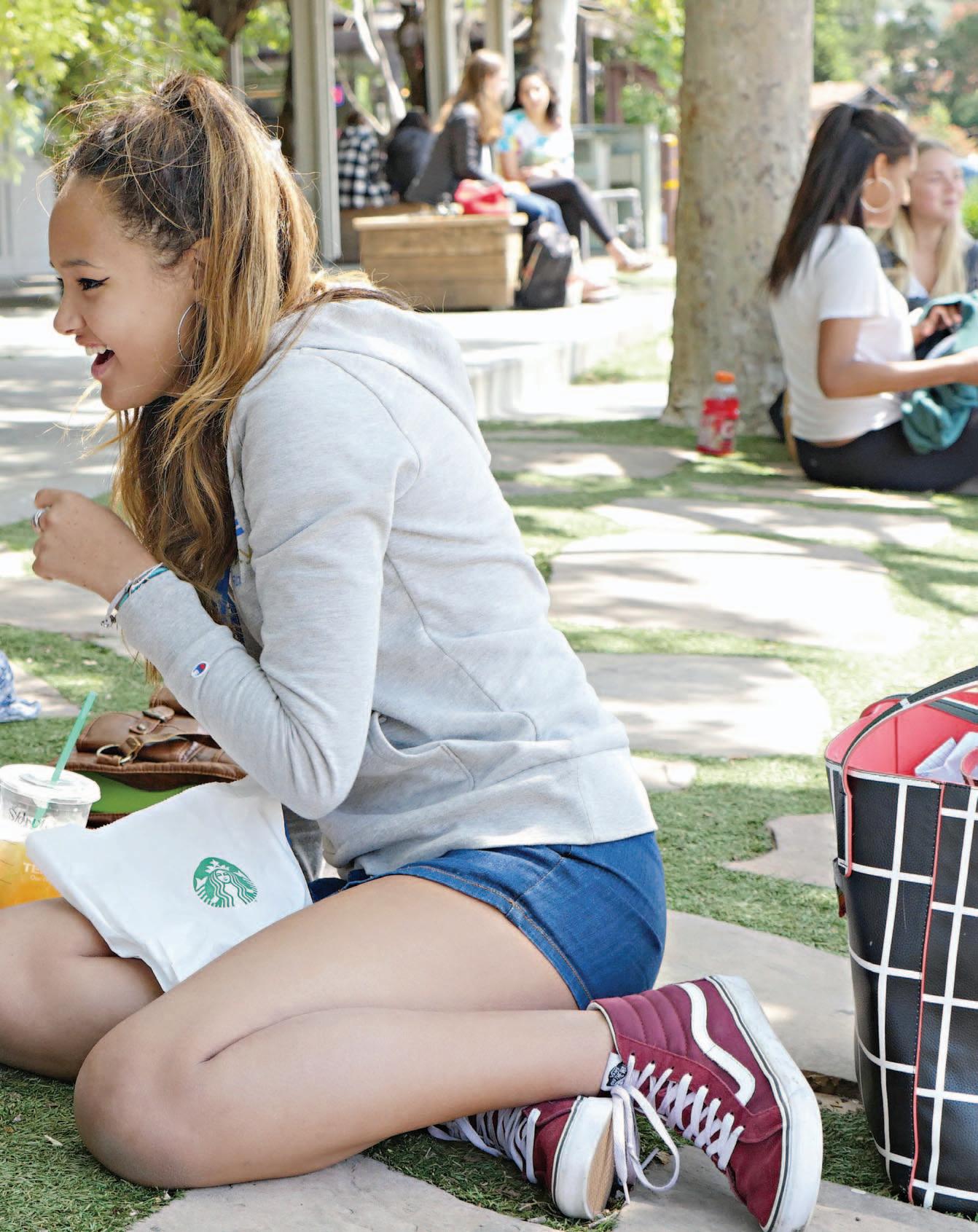 Sydney Brown, 15, right, spends time with friends Pamela Ferrety, 15, left, and Lillian Einhoen, 14, off campus during a lunch break from Tamalpais High School in Mill Valley.
Sydney Brown, 15, right, spends time with friends Pamela Ferrety, 15, left, and Lillian Einhoen, 14, off campus during a lunch break from Tamalpais High School in Mill Valley.
dia and sexting, and all that puts even more pressure on kids.”
A survey by the Pew Research Center last year found that 24 percent of teens go online “almost constantly,” thanks to the proliferation of smartphones. More than 90 percent of teens, defined as those aged 13 to 17, said they were online daily, while more than half were online several times a day Facebook, the study showed, was the most-used social media site among American teens, with 71 percent of all teens using the platform. Half used Instagram, and 40 percent were on Snapchat.
All that digital dialogue and photo-swapping throws fuel on the fires burning within these identity-seeking young adults, while their worried and sometimes angry parents look on in bewilderment
SHEPHERDING ONE’S children through their teenage years can be one of the most
daunting parental duties of all. It’s a messy, heart-wrenching slog — and that’s on the good days
“As a school counselor in the East Bay, I saw a lot of parents actually fearing the coming teen years,” says counselor Amy Specter, the mother of a 14-year-old son and 11-year-old daughter, and who estimates she has worked with more than 1,000 kids in her career Sure enough, when the teen years arrived, parents got frustrated.
“Parents would come into my office and say things like, ‘I give up. I feel disempowered and no longer have any inroads into the way my own child thinks’ ”
And while some kids veer off into a sort of self-imposed emotional quarantine, suffering from problems that include depression, anorexia or even suicidal thoughts, other teens suffer from trying desperately to excel.
“It’s tough enough being a teenager, but especially here in the Bay Area, where you’re sur-
rounded by really high achievers,” says Sydney Brown, a high school freshman from Mill Valley Sydney and her mom, Carolyn Carpeneti, an entrepreneur and author, both stress the importance of communication in navigating the teen years.

“My motto,” Carpeneti says, “is to be curious but not critical. And what’s really worked for me raising my son and daughter was taking notice of my kids’ passions. With my son it was airplanes, and with my daughter it’s scuba diving, and sharing that always gave us something to talk about, especially in those years when you’re lucky to even get an ‘uh’ or an ‘ugh’ out of them.”
While Sydney says she and her mom have a close relationship, that doesn’t necessarily mean they’re best friends. “My mom gives me advice on friends, on boys, on what to wear But she’ll also give me space when I ask for it,” she said
Those are common themes in the teen-parent dialogue: Parents should give kids their input, even if it seems like they’re hitting a wall. Kids will internalize their parents’ values, so be conscious of the values you’re projecting, and be aware of the many fine lines that exist when hypersensitive teenagers are involved.
“Our kids are extensions of ourselves, and it’s very difficult for parents to separate themselves from their children and the paths they’re choosing to take,’’ says Michelle Skeen, a psychologist in San Francisco with three kids, including a 19-year-old daughter To learn where their teens are at “means truly listening to their kids with an open mind and an open heart. But as soon as they interrupt to interject their advice or think they know better, the kids will push back And that’s when you’ll start to have problems”
68 KIDS BAY AREA NEWS GROUP
PMAY@BAYAREANEWSGROUPCOM
Smarana Abbadasari, 13, talks with Ethan Boyd, 14, during class at Discovery Charter School in San Jose.
Do it yourself
Balloon sound
PROJECT COURTESY OF THE EXPLORATORIUM, SAN FRANCISCO
This project is all about the sound of science. Using a balloon and some carbon dioxide, teens can create their own sound-amplifying apparatuses (as if the music they listen to weren’t loud enough). Think of it as an aural magnifying glass. As sound waves enter the balloon, they slow and bend. The balloon focuses the waves to create a loud spot. The project comes from San Francisco’s Exploratorium, where visitors of all ages can immerse themselves in learning about science, art and perception. For a teen twist on the experiment, try amplifying a cellphone or some favorite tunes. Who knew that learning about the properties of gases could sound this good?
MATERIALS
Sturdy balloon (12-16 inches in diameter), a way to fill the balloon with carbon dioxide (CO2) just before use, such as crushed dry ice (available at many supermarkets and fishing/bait shops), thick leather gloves (if using dry ice), tongs (if using dry ice), a flask or 1- or 2-liter plastic soda bottle.
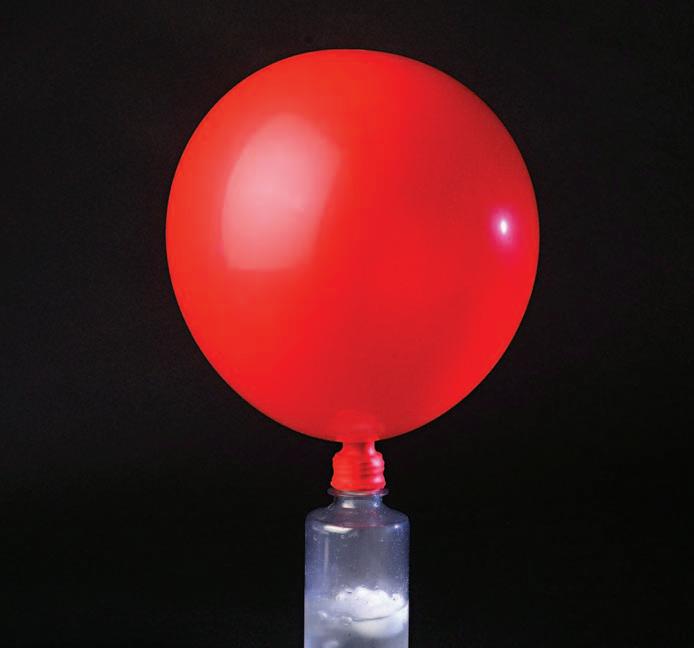
Optional: toy metal clicker or other noisemaker such as a cellphone.
PROCESS
Inflate the balloon with carbon dioxide gas. If using dry ice, put ¼ cup into the bottle. Fit the balloon over the top of the bottle. The balloon will slowly fill as the dry ice warms (10-15 minutes). When the balloon is full, remove, and tie it off Have one person hold the balloon up to her ear and another experiment with the level and position of sound on the other side.
69 BAY AREA NEWS GROUP KIDS TEEN
DOUG DUR AN
PARENTS’ BIGGEST FEARS
ESSAY BY CHUCK BARNEY ILLUSTRATION BY MARIE ASSÉNAT
Sometimes good and bad news come intertwined. To wit: As my son David’s senior year of high school wound down, he learned that his academic achievements qualified him to be class salutatorian. That was the good news. The bad news? The salutatorian had to deliver a graduation speech in front of a jampacked football stadium. Gulp. While David never inherited my love for sports, he did acquire the same paralyzing shyness I had at that age. Lord, we worry about so many things during the teen years bullying, substance abuse, teen pregnancy, the internet. Why add this one to the list? My wife, Diane, gave David a major pep talk and made sure he rehearsed his speech ad nauseam. Still, I was a wreck on grad night. Negative images ran through my brain: David tripping on the way to the podium. The wind blowing away the pages of his speech. Him choking in crunchtime. After years of raising our children, there comes a time when we must loosen the reins. As our kids move through youth and into adulthood, they will make decisions good and bad — that are informed by the way we raised them. We need to trust them and trust that, after all that parenting, they are prepared to create a fulfilling life for themselves. As for my son ’ s speech, it went well. He delivered his lines crisply and with confidence. The crowd laughed in all the right places. As he left the stage, I absolutely beamed with pride. Maybe our kid was ready to navigate this great big world after all.
70 KIDS BAY AREA NEWS GROUP TEEN
AND L I T T L ES T

71 BAY AREA NEWS GROUP KIDS
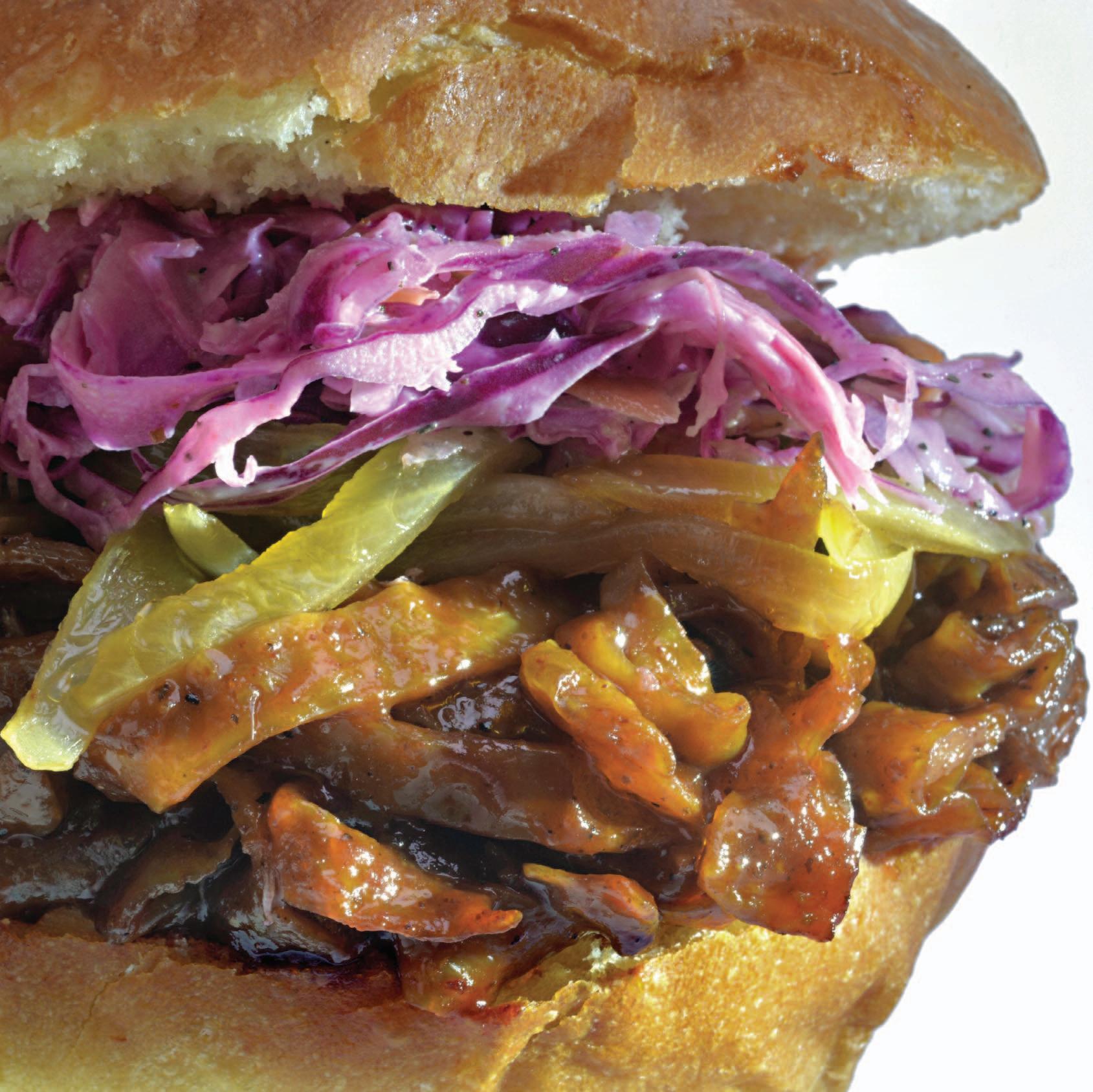
Food they’llactuallyeat
VeganPulled“Pork”SandwichWithCreamyColeslaw
RECIPE COURTESY OF PETER FIKARIS, BUTCHER’S SON
The teenage years often are when identity begins to really emerge, passions develop and perspectives broaden. For the eco-conscious teen starting to think about the world around her, there is no better or more responsible — place to eat than Butcher’s Son in Berkeley. There you can find delicious facsimiles of meat-laden products and feel good about eating them. This delicious spin on a classic gets a zip from chili powder, some sweet tang from barbecue sauce and creaminess sans cream, or any animal product, mind you from the vegan mayo in the coleslaw. Who said Meatless Mondays can’t last all week?
INGREDIENTS
“Pork” and onions
1 pound yuba (tofu skin)
¼ cup high-temperature cooking oil (such as peanut oil or extra-virgin olive oil)

½ teaspoon salt
½ teaspoon black pepper
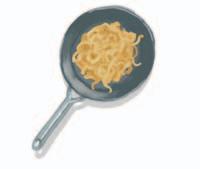
½ teaspoon chili powder

1 cup barbeque sauce
1 medium yellow onion
Creamy coleslaw

1 head each shredded green and purple cabbage
2 shredded carrots
¼ cup apple cider vinegar
Prepare the coleslaw with green cabbage, purple cabbage, carrots, apple cider vinegar, salt, black pepper, vegan mayonnaise.
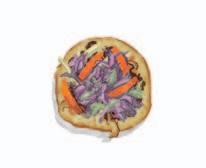


Combine. Prepare the “pork” with yuba sliced into thin strips, oil, salt, black pepper, chili powder
Combine.
2 teaspoons salt
2 teaspoons black pepper

1 cup vegan mayonnaise (preferably Hampton Creek’s Just Mayo)
Saute yuba on medium heat until lightly browned
Turn heat to low, and cook with barbecue sauce for 10 minutes, or until hot.
Slice the onion into thin strips. Saute with oil on medium-high heat until soft and browned.
Build the sandwich. Serve “pork” on a soft bun with cooked onions and creamy coleslaw
73 BAY AREA NEWS GROUP KIDS TEEN
PHOTOGRAPH BY DOUG DURAN, ILLUSTRATIONS BY JEFF DURHAM
Hit the dirt
If you have a dirtjumping daredevil or two on your hands, take them to Pleasanton’s BMX park, a spot that’s perfect for novices but also offers up enough berms, hills and jumps to satisfy more advanced riders for hours. Just don’t forget to pack the safety gear and sunscreen.

The park, which is open during daylight hours and draws solo riders and families alike, is at 3320 Stanley Blvd.
Out and about
BY TOR HAUGAN
True colors
Teens will have a ball as they blast one another with bursts of vibrant colors in the ultimate paintball battle at American Paintball Park, located just over a mile off Highway 580. Youths ages 12 and older can take to one of the large outdoor fields, suited for everyone from beginning to advanced paintballers Reservations are not required, but private parties need to be booked at least a week in advance.
American Paintball Park is at 1230 Greenville Road. For details, call 925-565-3118
Fire the lasers
This is not the childhood game of tag your grandparents used to play. This game has lasers, and everything is better with lasers. The games at Nor Cal Laser Tag in San Jose take place outdoors, like paintball, but, unlike paintball, there are no physical projectiles. Reservations are required for groups of 10 or more.
Nor Cal Laser Tag is at 2542 Monterey Road. For details, go to http://norcallasertag.com.
Let it fly
Do your kids want to skydive but you’re deathly afraid of a parachute mishap? Or maybe you just want to turn your recurring dream of flying into reality during a familyfriendly outing No matter what brings you and the kids to iFly in Union City, everyone is bound to have a great time soaring in the vertical wind tunnel with the assistance of an instructor iFly says it welcomes fliers from 3 to 103 Sorry, 104-yearolds — you’ll have to sit this one out
iFly is at 31310 Alvarado-Niles Road. For details and restrictions, call 510-489-4359
Have aball
Although table tennis as a sport may not be as popular in the U S. as it is in Europe and Asia (beer pong is another story), there are still devotees and many places to play in the Bay Area. Whether your kid is an advanced player or a novice, be sure to check out The TopSpin in San Jose, where children can play or improve their game through classes and camps.
The TopSpin is at 1150 Campbell Ave For details, call 408-970-5078
74 KIDS BAY AREA NEWS GROUP TEEN
B A Y AREA N EW S G R OUP
“GIVE THE ONES YO U LOV E WINGS TO FLY, ROOT S TO C OME BACK AND REA SONS TO STAY. ”
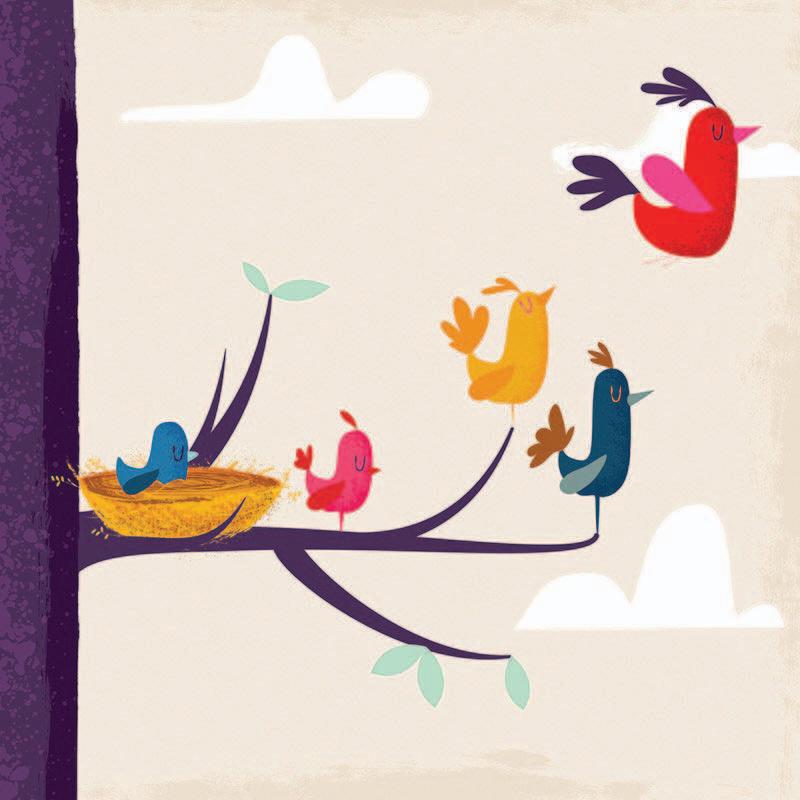 ILLUSTRATION BY ANDREW BANNECKER
THE DALAI LAMA
ILLUSTRATION BY ANDREW BANNECKER
THE DALAI LAMA







 DANIA CHAUDHRY, 4
DANIA CHAUDHRY, 4





 ILLUSTRATION BY KEITH NEGLEY
ILLUSTRATION BY KEITH NEGLEY

















 ILLUSTRATION BY KEITH NEGLEY
ILLUSTRATION BY KEITH NEGLEY




















 ILLUSTRATION BY KEITH NEGLEY
STORY BY JON WILNER
PHOTOGRAPHS BY JIM GENSHEIMER
ILLUSTRATION BY KEITH NEGLEY
STORY BY JON WILNER
PHOTOGRAPHS BY JIM GENSHEIMER





















 ILLUSTRATION BY KEITH NEGLEY
ILLUSTRATION BY KEITH NEGLEY




















 ILLUSTRATION BY KEITH NEGLEY
ILLUSTRATION BY KEITH NEGLEY




 Sydney Brown, 15, right, spends time with friends Pamela Ferrety, 15, left, and Lillian Einhoen, 14, off campus during a lunch break from Tamalpais High School in Mill Valley.
Sydney Brown, 15, right, spends time with friends Pamela Ferrety, 15, left, and Lillian Einhoen, 14, off campus during a lunch break from Tamalpais High School in Mill Valley.













 ILLUSTRATION BY ANDREW BANNECKER
THE DALAI LAMA
ILLUSTRATION BY ANDREW BANNECKER
THE DALAI LAMA





















